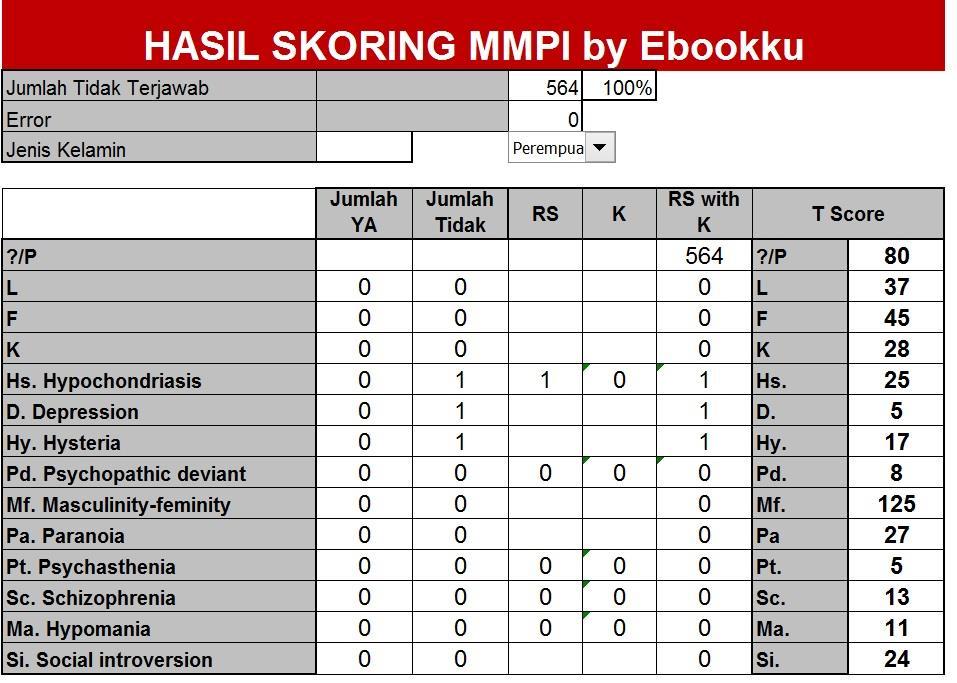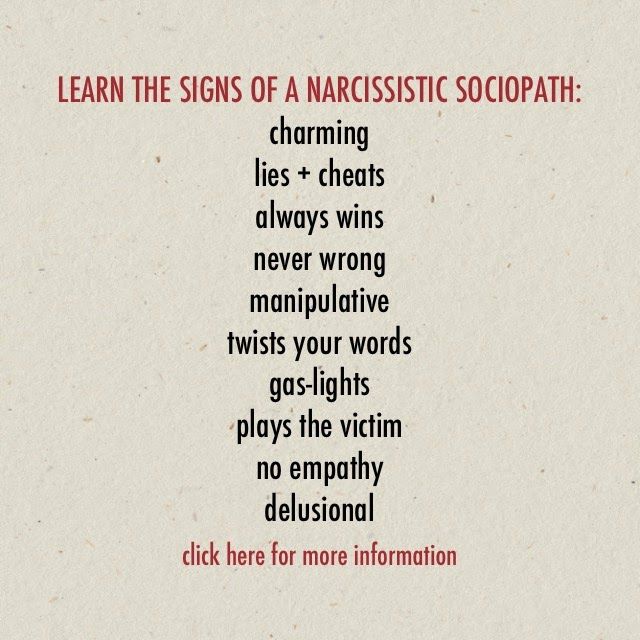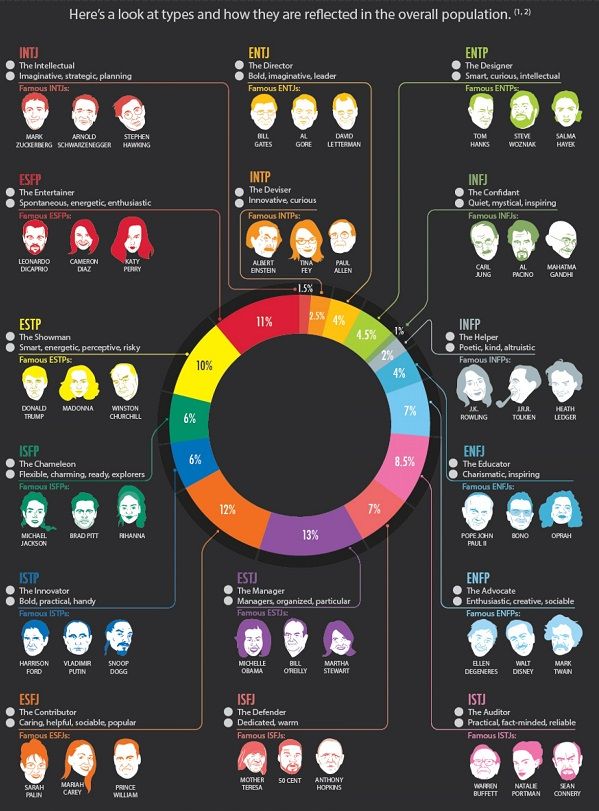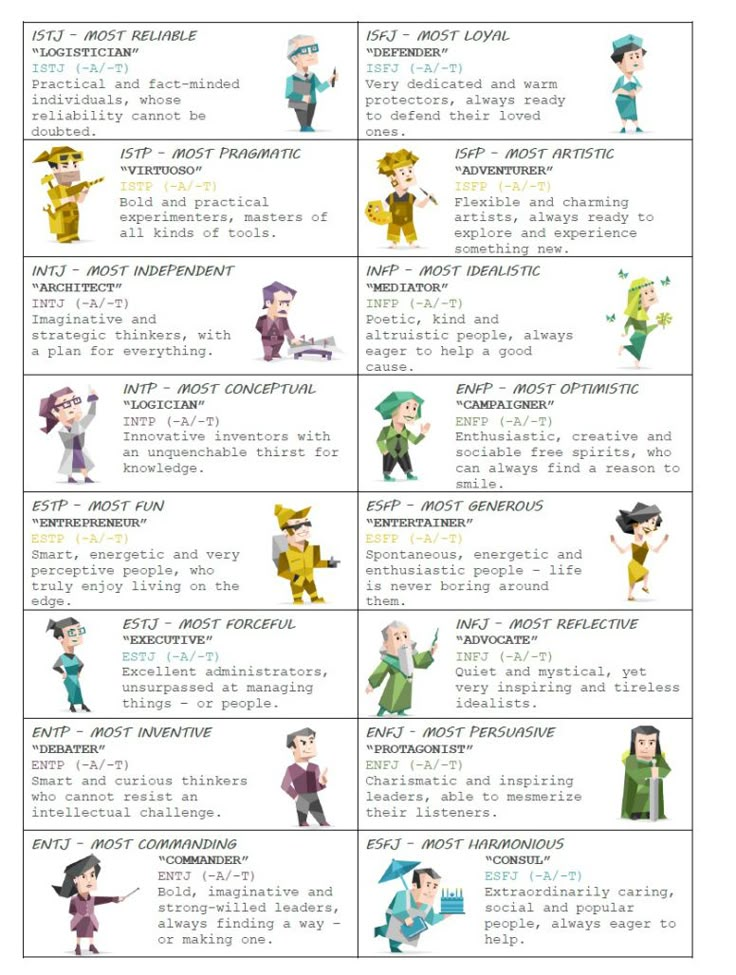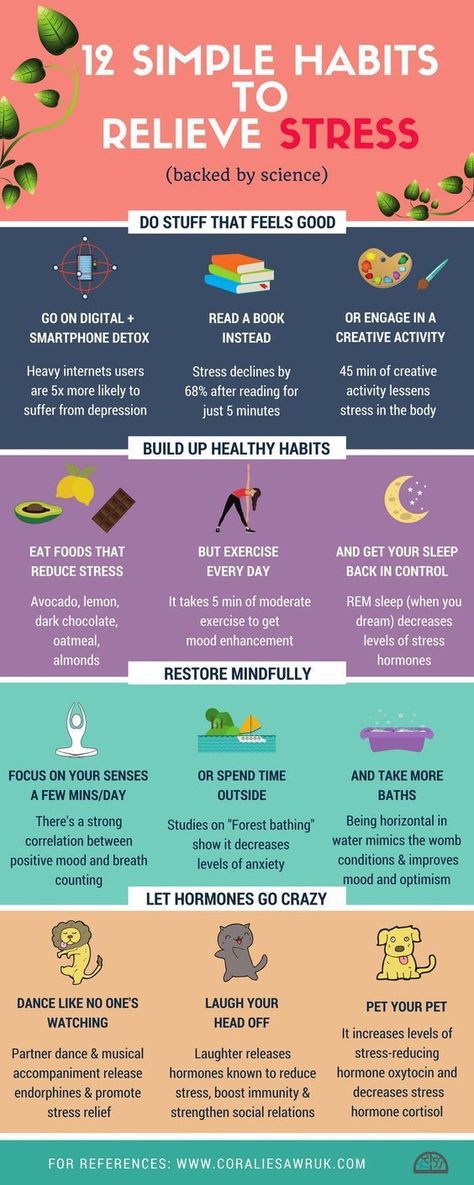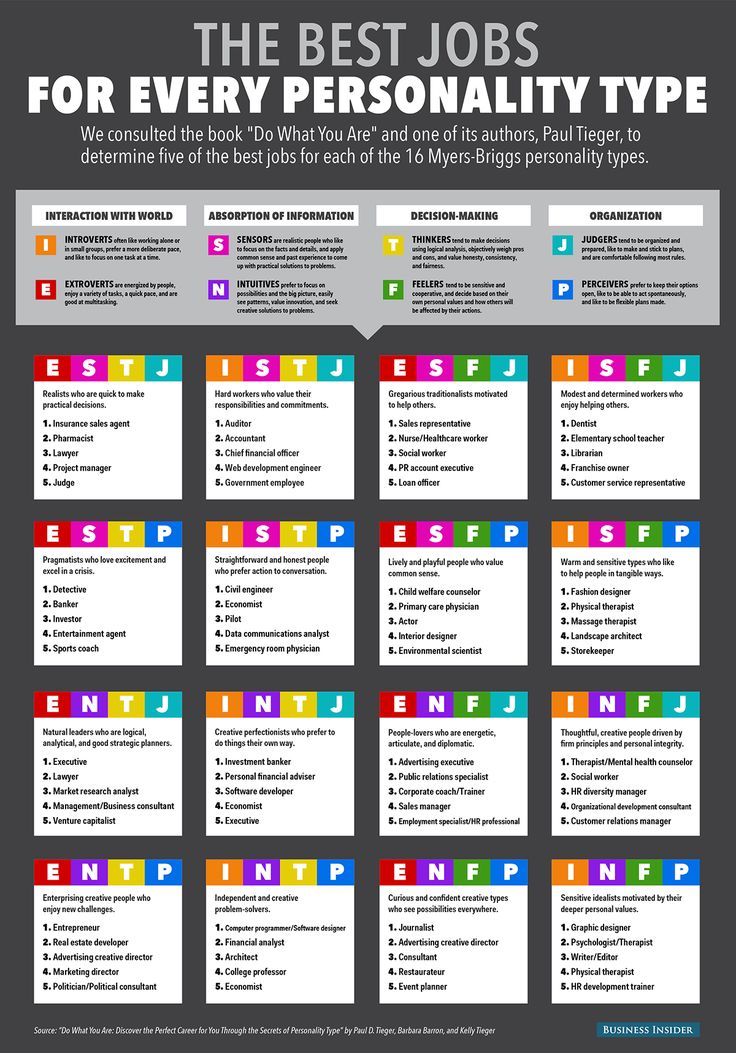What does the minnesota multiphasic personality inventory measure
Minnesota Multiphasic Personality Inventory (MMPI)
Description
The Minnesota Multiphasic Personality Inventory (MMPI) is a psychological test that assesses personality traits and psychopathology. It is primarily intended to test people who are suspected of having mental health or other clinical issues. Although it was not originally designed to be administered to non-clinical populations, it can be used to assess psychological stability in workers in ‘high-risk’ professions such as airline pilots, police or workers in the nuclear power industry, although using it in this manner is controversial.
Administration
The MMPI is currently commonly administered in one of two forms — the MMPI-2, which has 567 true/false questions, and the newer MMPI-2-RF, published in 2008 and containing only 338 true/false items. While the MMPI-2-RF takes about half the time to complete (usually about 40 to 50 minutes), the MMPI-2 is still the more widely used test because of its existing large research base and familiarity among psychologists.
(Another version of the test — the MMPI-A — is designed exclusively for teenagers.)
The MMPI is considered a protected psychological instrument, meaning it can only be given and interpreted by a psychologist trained to do so (you cannot find the test online). While it’s commonly administered by computer nowadays (and requires no direct professional involvement during its administration), psychological testing is nearly always preceded by a clinical interview by the psychologist who is doing the testing. After the computer scores the test results, the psychologist writes up a report interpreting the test results in the context of the person’s history and current psychological concerns.
Methodology
The MMPI-2 is designed with 10 clinical scales. which assess 10 major categories of abnormal human behavior, and four validity scales, which assess the person’s general test-taking attitude and whether they answered the items on the test in a truthful and accurate manner.
The 10 Clinical Subscales of the MMPI-2, require answering certain questions on the test in a specific manner: 1.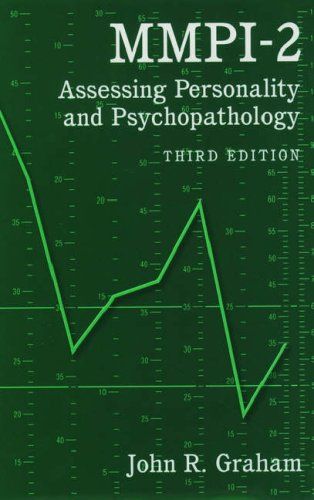 Hypochondriasis – Looks at a wide variety of vague and nonspecific complaints about bodily functioning. 2. Depression – Measures clinical depression, which is characterised by poor morale, lack of hope in the future, and a general dissatisfaction with one’s life. 3. Hysteria – Primarily measures five components — poor physical health, shyness, cynicism, headaches and neuroticism. 4. Psychopathic Deviate – Measures general social maladjustment and the absence of strongly pleasant experiences. 5. Masculinity/Femininity – Measures interests in vocations and hobbies, aesthetic preferences, activity-passivity and personal sensitivity. 6. Paranoia – Primarily measures interpersonal sensitivity, moral self-righteousness and suspiciousness. 7. Psychasthenia
– Is intended to measure a person’s inability to resist specific actions or thoughts, regardless of their maladaptive nature.
Hypochondriasis – Looks at a wide variety of vague and nonspecific complaints about bodily functioning. 2. Depression – Measures clinical depression, which is characterised by poor morale, lack of hope in the future, and a general dissatisfaction with one’s life. 3. Hysteria – Primarily measures five components — poor physical health, shyness, cynicism, headaches and neuroticism. 4. Psychopathic Deviate – Measures general social maladjustment and the absence of strongly pleasant experiences. 5. Masculinity/Femininity – Measures interests in vocations and hobbies, aesthetic preferences, activity-passivity and personal sensitivity. 6. Paranoia – Primarily measures interpersonal sensitivity, moral self-righteousness and suspiciousness. 7. Psychasthenia
– Is intended to measure a person’s inability to resist specific actions or thoughts, regardless of their maladaptive nature. 8. Schizophrenia – Measures bizarre thoughts, peculiar perceptions, social alienation, poor familial relationships, difficulties in concentration and impulse control, lack of deep interests, disturbing question of self-worth and self-identity, and sexual difficulties. 9. Hypomania – Is intended to measure milder degrees of excitement, characterized by an elated but unstable mood, psychomotor excitement (e.g., shaky hands) and flight of ideas (e.g., an unstoppable string of ideas). 10. Social Introversion – Measures the social introversion and extroversion of a person.
8. Schizophrenia – Measures bizarre thoughts, peculiar perceptions, social alienation, poor familial relationships, difficulties in concentration and impulse control, lack of deep interests, disturbing question of self-worth and self-identity, and sexual difficulties. 9. Hypomania – Is intended to measure milder degrees of excitement, characterized by an elated but unstable mood, psychomotor excitement (e.g., shaky hands) and flight of ideas (e.g., an unstoppable string of ideas). 10. Social Introversion – Measures the social introversion and extroversion of a person.
Barriers
The MMPI is not a valid measure of a person’s psychopathology or behavior if the person taking the test does so in a way that is not honest or frank. A person may decide, for whatever reasons, to overreport (exaggerate) or underreport (deny) the behavior being assessed by the test. The four validity scales are designed to measure a persons test-taking attitude and approach to the test:
- Lie – The Lie scale is intended to identify individuals who are deliberately trying to avoid answering the MMPI honestly and in a frank manner.

- F – The F scale (the “F” does not stand for anything, although it is mistakenly sometimes referred to as the Infrequency or Frequency scale) is intended to detect unusual or atypical ways of answering the test items, like if a person were to randomly fill out the test.
- Back F – The Back F scale measures the same issues as the F scale, except only during the last half of the test.
- K – The K scale is designed to identify psychopathology in people who otherwise would have profiles within the normal range. It measures self-control, and family and interpersonal relationships, and people who score highly on this scale are often seen as being defensive.
Related Articles
- Pilot_Mental_Health
Further Reading
- Minesota Multiphasic Personality Inventory by Jane Framingham, Ph.D., updated October 2018
Minnesota Multiphasic Personality Inventory - StatPearls
Augustus E.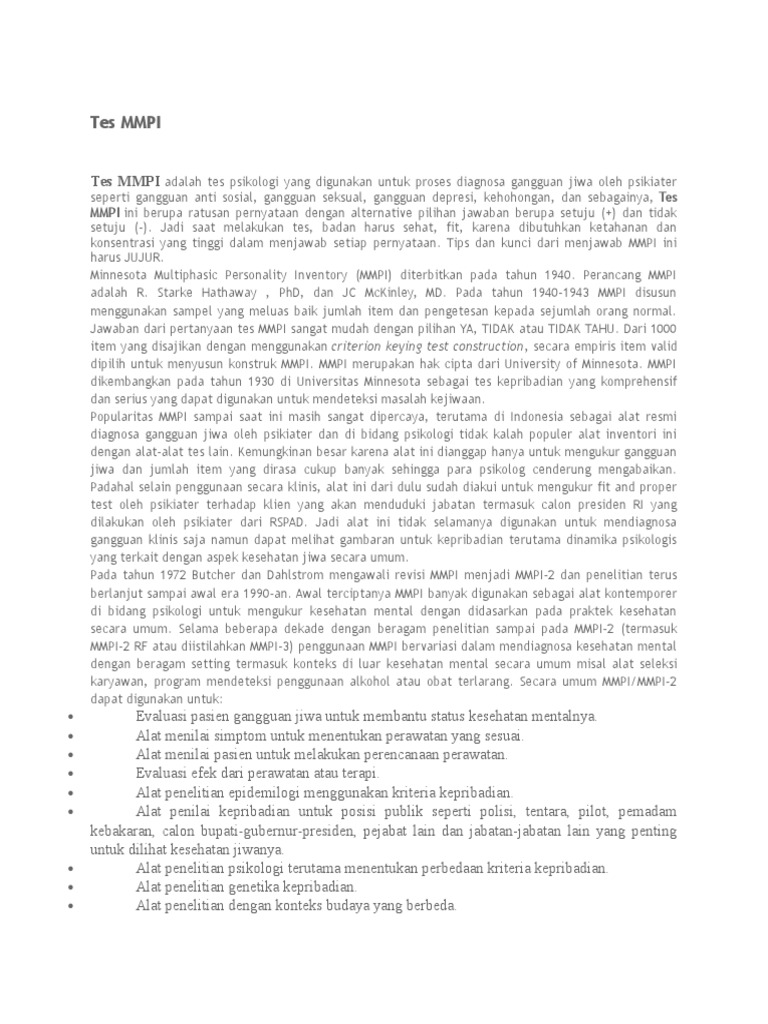 Floyd; Vikas Gupta.
Floyd; Vikas Gupta.
Author Information
Last Update: April 28, 2022.
Definition/Introduction
The Minnesota Multiphasic Personality Inventory (MMPI) is the most common psychometric test devised to assess personality traits and psychopathology. This data can be used to draw conclusions about the test taker’s psychopathy or to interpret psychological characteristics compared to the norm.[1] The most common treatment application of the test by providers is establishing or reevaluating care for an ambiguous clinical picture.[2] For psychiatric management, this aids in creating generalizable data relevant to a plethora of possible conditions.[1][2]
The MMPI was developed in the 1930s and published through the University of Minnesota in 1942 by Stuart Hathaway and Charley McKinley using visitors of patients at the University of Minnesota hospital as a base sample in both theorizing constructs of psychiatric illness and fielding the instrument.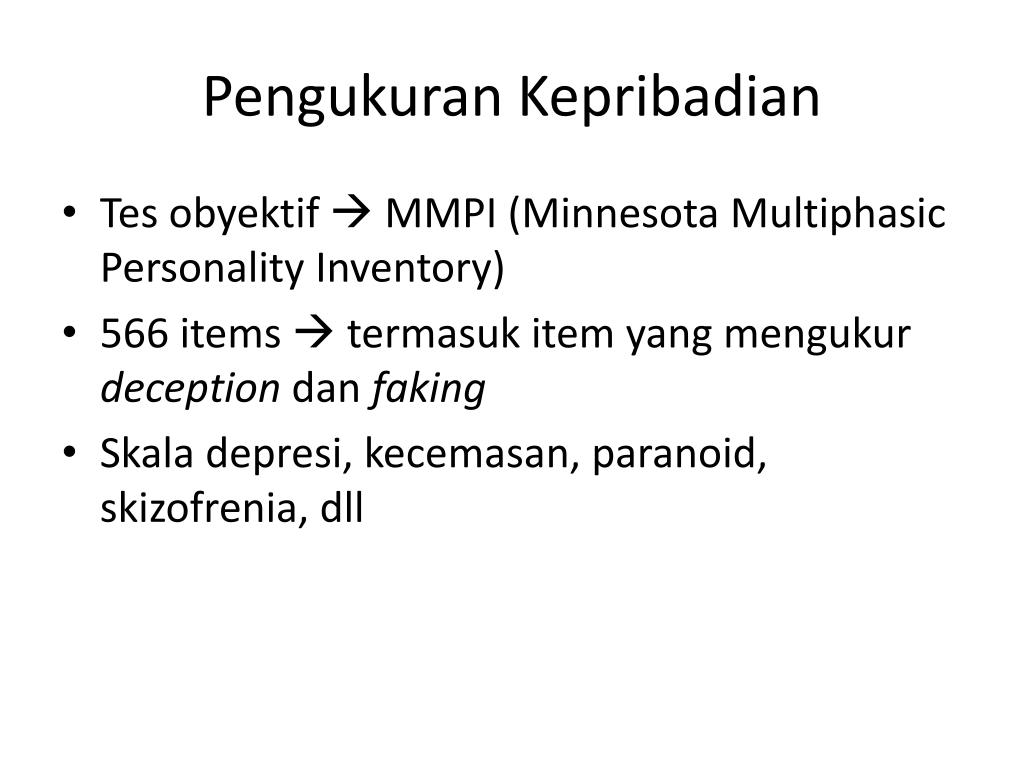 Testing is administered through 567 true or false items using a booklet with an accompanying answer sheet. The responses are then hand-scored and plotted on an X-Y graph; a separate version is used for male and female respondents.[3]
Testing is administered through 567 true or false items using a booklet with an accompanying answer sheet. The responses are then hand-scored and plotted on an X-Y graph; a separate version is used for male and female respondents.[3]
The X-axis is comprised of 14 scales. The first four ‘content scales’ judge the validity of the test attempt and include:
? to represent the number of questions completed incorrectly, either with no attempt or both ‘true’ and ‘false’ selected
L for ‘Lie’ to represent an attempt by the respondent to misrepresent themselves in a more positive light
F or ‘frequency’ to gauge random response as well as the respondent’s exaggeration or downplaying of symptoms
K to gauge ‘defensiveness,’ or evasion of stressful content
The 10 remaining scales known as ‘clinical scales’ are designed to measure for the presence of psychiatric syndromes, including:
1 or ‘Hs’ for hypochondriasis
2 or ‘D’ for depression
3 or ‘Hy’ for hysteria
4 or ‘Pd’ for psychopathic deviate
5 or ‘Mf’ for the continuum of masculinity-femininity
6 or ‘Pa’ for paranoia
7 or ‘Pt’ for psychasthenia or obsessive-compulsive tendency
8 or ‘Sc’ for schizophrenia
9 or ‘Ma’ for mania
0 or ‘Si’ for social introversion.

The Y-axis statistically standardizes the grading received on each scale in a range of T-scores from 0 to 120. A mean score is 50, and 82% of respondents are considered the normal population falling between 30 and 70. A T-score greater than 70 indicates psychopathy in that category.
Issues of Concern
The existence of the MMPI has been concurrent with vast reforms in societal convention and increased understanding of behavioral health.[3] Likewise, the instrument has been adapted to reflect such changes. Overarching criticisms to the original test center on its disparity in addressing psychopathy in social and ethnic minorities.[1] This has been attributed to the original sample being a small group, mainly consisting of young rural Caucasian subjects from the Midwestern United States.[4] Studies have established biases in which misunderstanding or failure to identify with the content of questions culturally has led to underreporting or overreporting mental illness.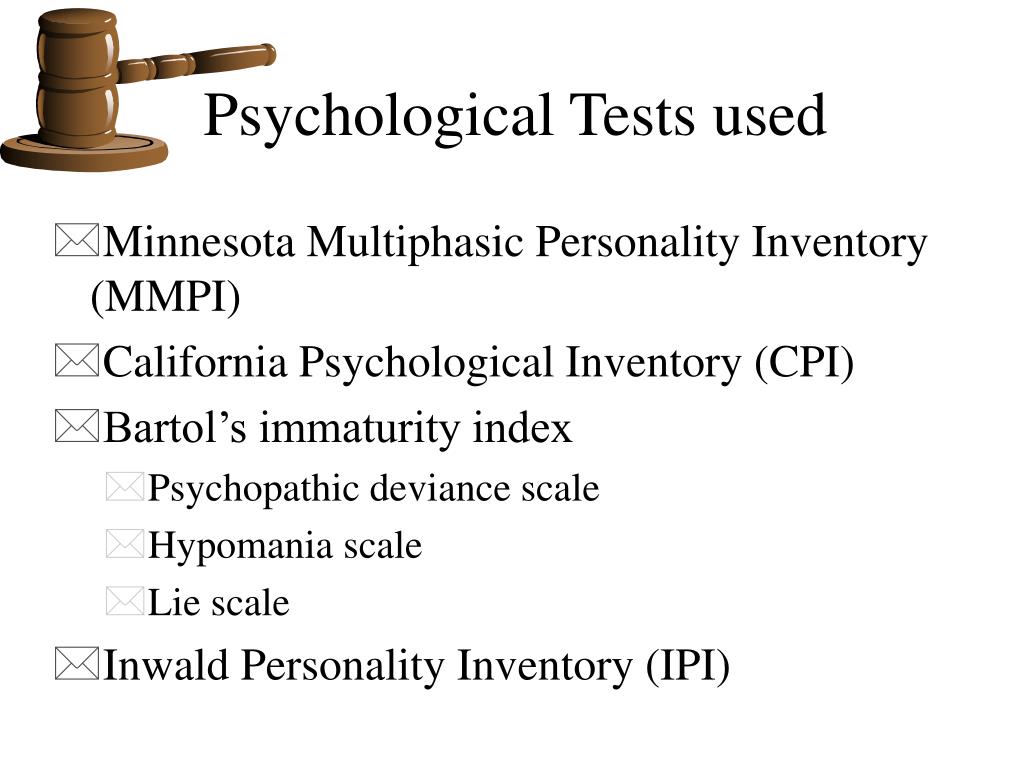 [5][1]
[5][1]
These shortcomings led to the release of the MMPI-2 by James N. Butcher, W. Grant Dahlstrom, John R. Graham, Auke Tellegen, and Beverly Kaemme in 1989.[6] This assessment retains the original total of 567 items with the same corresponding 14 scales with the original number of questions from the test.[6] Test items were revised based upon a larger and more diverse sample size of 2600 attuned to a 6th-grade reading level.[6] Gendered differences were replaced with a nongendered standardized scoring.[6] Despite further advancements, the MMPI-2 is still the most commonly administered version and has been translated into over 40 languages.[1]
In 2003, 9 restructured clinical or ‘RC’ scales were introduced as a prospective replacement for the original clinical scales.[1] These include:
RCd, or ‘demoralization’ – misery or depression
RC1 or ‘somatic complaints, – the fixation on bodily symptoms of illness or somatization
RC2 or ‘low positive emotions’ – weakened positivity, lack of enjoyment
RC3 or ‘cynicism’ – low regard for the merit of others and their actions
RC4 or ‘antisocial behavior’ – selfish and sociopathic conduct
RC6 or ‘ideas of persecution’ – belief in the malintent of others toward oneself
RC7 or ‘dysfunctional negative emotions’ – experiences on a spectrum of anxiety and irritability
RC8 or ‘aberrant experiences’ – uncommon beliefs or interpretation of experiences
RC9 or ‘hypomanic activation’ – energetic drive and desire for exertion
The RC scales were devised to provide a streamlined interpretation and less overlap with an increased focus on the growth in understanding within psychiatry over the past 70 years.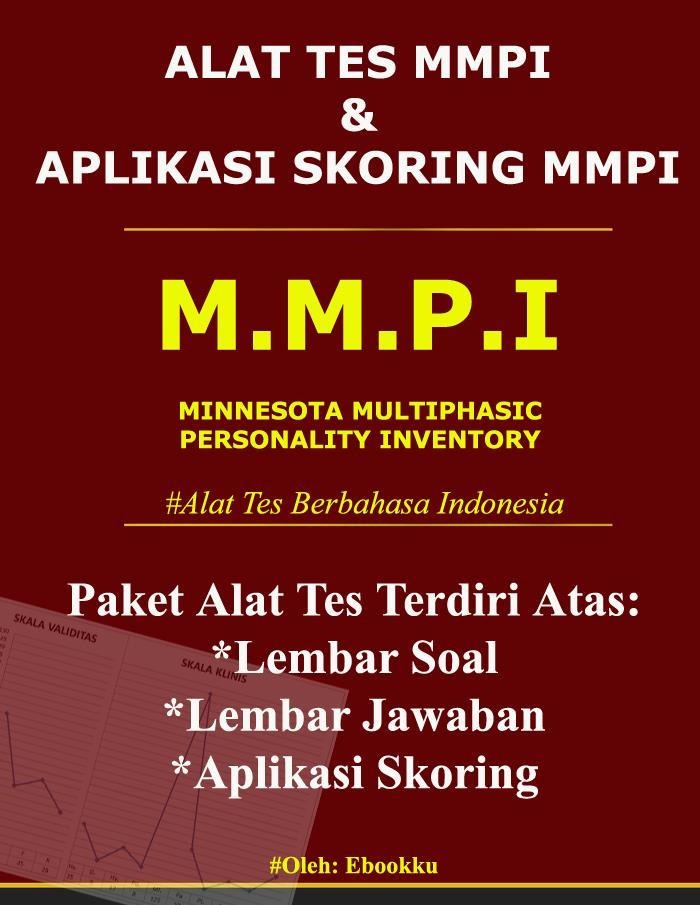 Combinations of high-scoring categories represent distinct psychiatric constructs rather than the nebulous findings of the original clinical scales tying the patient to a specific diagnosis. Arguments also exist that this information is limited in that it categorizes the responder rather than providing data on an individual patient within a personalized spectrum of behavior.[1]
Combinations of high-scoring categories represent distinct psychiatric constructs rather than the nebulous findings of the original clinical scales tying the patient to a specific diagnosis. Arguments also exist that this information is limited in that it categorizes the responder rather than providing data on an individual patient within a personalized spectrum of behavior.[1]
The RC scales were incorporated into the most current form of the MMPI, known as the Minnesota Multiphasic Personality Inventory-2 Revised Form, or the MMPI-2-RF, which was released in 2008 by Yossef Ben-Porath and Auke Telleger of the University of Minnesota. The MMPI-2-RF is composed of 338 items measured by 51 scales broken into 9 validity scales, 3 higher-order scales, the 9 RC scales, 23 specific problem scales, 2 interest scales, and 5 revised personality psychopathy scales.[1]
The 9 validity scales assess incongruent answering or deceptive test-taking and include:
VRIN-r or ‘variable response inconsistency’ – inconsistent reporting of items
TRIN-r or ‘true response inconsistency’ careless reporting of items
F-r or ‘infrequent responses,’ – overreporting of infrequent responses compared to the norm
Fp-r or ‘infrequent psychopathology responses’ – overreporting of infrequent responses compared to those with psychopathy
Fs or ‘infrequent somatic responses’ – overreporting of infrequent responses compared to medical patients
FBS-r or ‘symptom validity’ – overreporting of nonvalid symptoms compared to both physical and mental standard symptomology
RBS or ‘response bias’ – overreporting associated with a statistically invalidated presentation of the disease
L-r or ‘uncommon virtues’ – underreporting through infrequently declared values or actions
K-r or ‘adjustment validity’ – underreporting by tailoring answers to give the impression of healthy psychological adjustment
The 3 higher-order scales broadly categorize psychopathic presentation and include:
EID or ‘emotional/internalizing dysfunction’ – problems concerning mood and affect
THD or ‘thought dysfunction’ – problems concerning disorganization of thought
BXD or ‘behavioral/external dysfunction’ – problems concerning impulsive or inappropriate behavior
The problem scales highlight responses consistent with the presence of specific psychopathic and psychosomatic presentations and include:
MLS or ‘malaise’
GIC or ‘gastrointestinal complaints’
HPC or ‘head pain complaints'
NUC or ‘neurological complaints’
COG or ‘cognitive complaints’
SUI or ‘suicidal/death ideation’
HLP or ‘helplessness/hopelessness’
SFD or ‘self-doubt’
NFC or ‘inefficacy’
STW or ‘stress/worry’
AXY or ‘anxiety’
ANP or ‘anger proneness’
BRF or ‘behavior-restricting fears’
MSF or ‘multiple specific fears’
JCP or ‘juvenile conduct problems’
SUB or ‘substance abuse’
AGG or ‘aggression’
ACT or ‘activation’
FML or ‘family problems’
IPP or ‘interpersonal passivity’
SAV or ‘social avoidance’
SHY or ‘shyness’
DSF or ‘disaffiliativeness’
The interest scales are designed to assess cognitive skills, aptitude, and learning preferences which include:
AES or aesthetic-literary interests – pursuits related to fine art
MEC or mechanical-physical interests – pursuits related to kinesthetic activities
The revised personality/psychopathology five scales are based on 107 distinct items and include:
AGG-r or ‘aggressiveness-revised’ – preference for excess and antagonism
PSYCH-r or ‘psychoticism-revised’ – preference for disconnection from reality
DISC-r or ‘disconstraint-revised’ – preference for impulsion and compulsion
NEGE-r or ‘negative emotionality/neuroticism-revised’ – preference for anxiety
INTR-r or ‘introversion/low positive emotional-revised’ – flat affect and timidity
It has been suggested that while the MMPI-2-RF has many additional metrics, the reduction in question number limits the amount of information about psychiatric diseases to about 60% of the original test. There has also been considerable debate over whether the new metrics are inaccurate in detecting psychopathy.[1] In separating genuine psychopathy from attempts to feign a diagnosis for personal incentive, some studies have noted the new validity scales to be overly sensitive to overreporting symptoms to achieve a specific result. It has conversely been found that the L-r and K-r scales are particularly reliable at detecting underreporting of mental illness.[7][8] Overall, literature has supported the MMPI-2-RF in identifying the accuracy of reporting psychiatric information in those who complete it.[1]
There has also been considerable debate over whether the new metrics are inaccurate in detecting psychopathy.[1] In separating genuine psychopathy from attempts to feign a diagnosis for personal incentive, some studies have noted the new validity scales to be overly sensitive to overreporting symptoms to achieve a specific result. It has conversely been found that the L-r and K-r scales are particularly reliable at detecting underreporting of mental illness.[7][8] Overall, literature has supported the MMPI-2-RF in identifying the accuracy of reporting psychiatric information in those who complete it.[1]
Clinical Significance
The MMPI maintains an enduring presence in the field of mental health, and its current adaption has been widely evaluated by the standard of modern behavioral health practices.[1] It continues to receive widespread application as a threshold of determining the presence of psychopathy, as a means of constructing a differential diagnosis for mental health problems, and as a versatile test to achieve transferrable psychological data.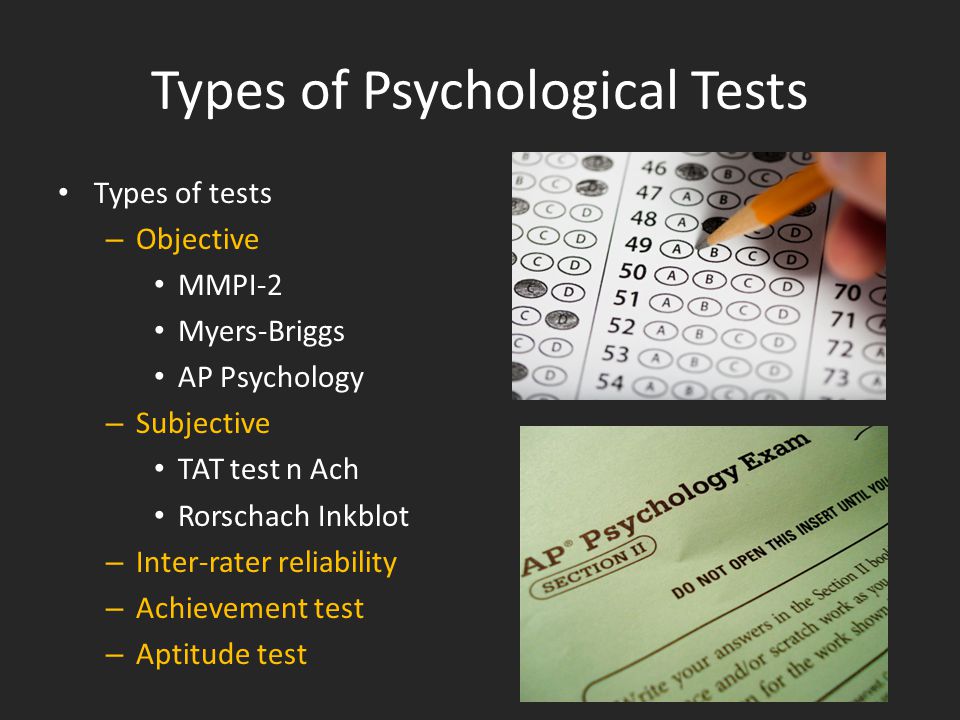 These data points indicate a category, which gives behavioral health professionals a starting point to explore plausible diagnoses and initiate appropriate treatment. Completion may also offer therapeutic benefits to patients in reflecting upon their issues and improving personal understanding of their psychology.[3]
These data points indicate a category, which gives behavioral health professionals a starting point to explore plausible diagnoses and initiate appropriate treatment. Completion may also offer therapeutic benefits to patients in reflecting upon their issues and improving personal understanding of their psychology.[3]
In addition to its predominant clinical application, an extensive body of research exists to assess the MMPI in all its versions for the use in criminology, population studies, and prediction of aptitude in a particular role. Several studies on the MMPI-2-RF have compared those with a criminal history to those who have undergone rehabilitation and found that high scores on externalizing scales were predictive of violent behavior.[9] The MMPI-2-RF has also been used to prescreen applicants for law enforcement to obtain baseline mental health or flagging for aggressive tendencies.[1][10] There has also been usage evaluating parenting suitability in custody battles over children and in predicting the course of domestic disputes in couples.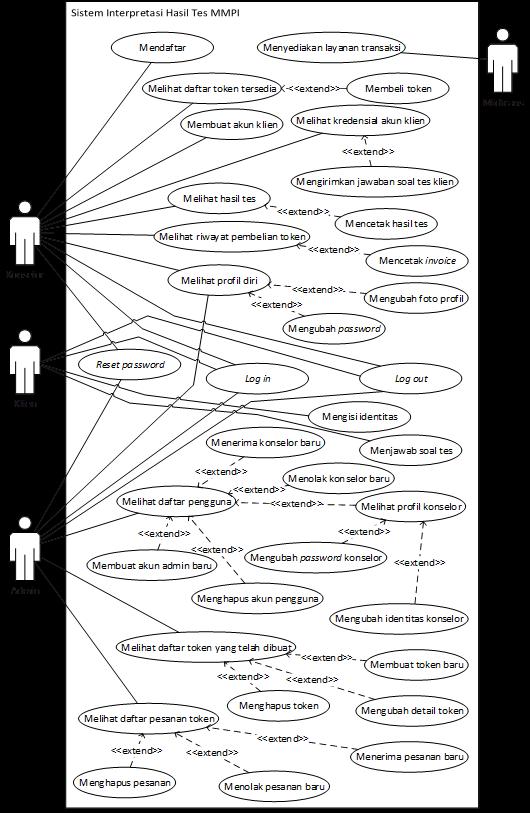 [11][12] Interpretations of the test have also been used to establish criminal intent in defendants.[1][9]
[11][12] Interpretations of the test have also been used to establish criminal intent in defendants.[1][9]
A major consensus of the MMPI in its current form is that increased accessibility for being tested improves retention without compromising outcomes. Prevailing criticisms of the original format were the extensive span of questioning and difficulty of paper administration for both completion and grading, with efforts to provide a more efficient medium well-documented since the 1980s.[13] When evaluating the use of tablet devices compared to conventional forms of electronic administration using a home computer or laptop for taking the MMPI-RF-2, the difference in reliability of results between the two mediums was insignificant.[14] There have also been motions to use the MMPI-2-RF to assess psychopathy utilizing an algorithm using a high score on a higher-order scale and then tailoring the remaining assessment to similar questions to the indicated higher order.[15] To aid in administration to pediatric patients, an adolescent form exists known as the Minnesota Multiphasic Personality Inventory-Adolescent-Restructured Form (MMPI-A-RF).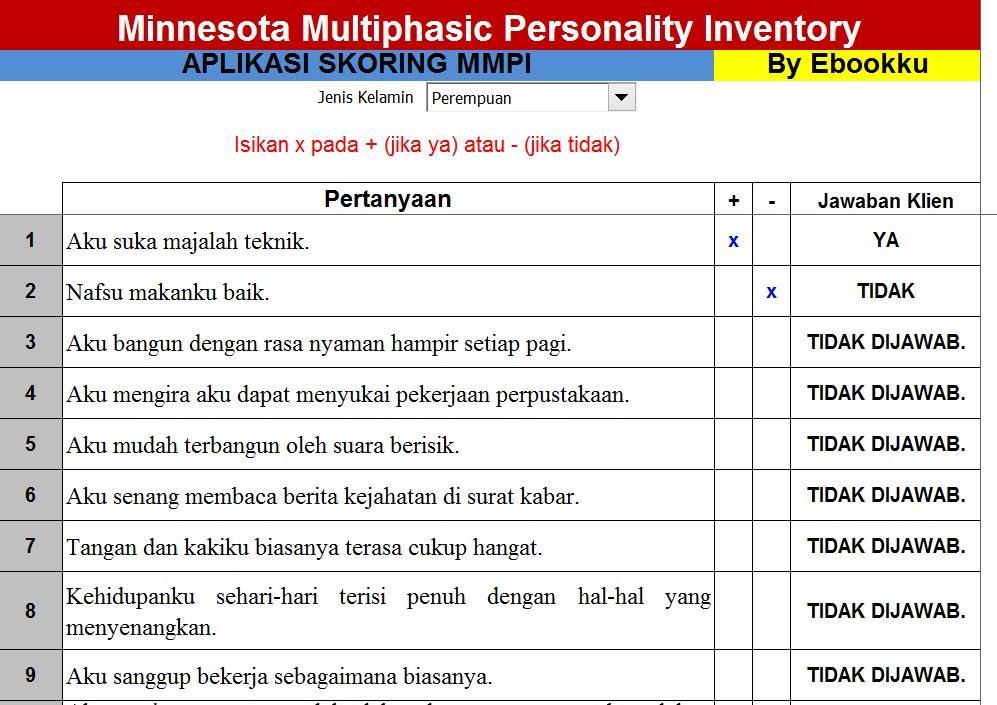 [16]
[16]
Clinical Pearls
The MMPI provides broad information about aspects of personality and the existence of components of psychopathology.
The MMPI is completed by indicating true/false to a series of declarative statements that identify personal beliefs or symptomology.
Interpretation is based upon scoring reasonably truthfully and consistently within the outlined scales of the test.
Scales in older versions represented clinical syndromes, while more recently developed scales are based on identifying symptoms that can be applied to appropriate conditions or disorders.
The MMPI is effective at distinguishing psychopathy from malingering or purposeful test-taking as well as from medical conditions.
The MMPI has been revised to make the test more efficient, reproducible to test-takers in a broader societal demographic, and more grounded in current theory.
The MMPI can be taken by an individual patient to provide evidence of their symptoms but can also be fielded to a population fitting a known category to observe trends within their scoring.

The MMPI has been applied to a variety of non-clinical settings, including legal evidence in criminal and civil cases and screening for employment.
The completion of the MMPI holds value in determining care throughout a variety of treatment considerations. The test should be administered by a licensed psychotherapist, usually a psychiatrist or clinical psychologist, with informed consent obtained by discussing the risks and benefits of completion. Analysis of the results by the psychotherapist interpreting scoring should be attached with a working diagnosis to assess for treatment response. The presence of conditions associated with high-scoring categories will ultimately guide the necessity for pharmacological or non-pharmacological treatment options. This will, in turn, outline the need for referral to appropriate mental healthcare, from continuing outpatient follow-up to institutionalization with fully-staffed nursing and rehabilitative care. Transfer of care should involve appropriate discussion of MMPI data correlated with a summary of interventions. High-scoring in concerning scales such as suicidality highlights an existing need for acute observation or placement. The validity of symptoms should also be corroborated to demonstrate whether a patient is malingering or suffering from organic disorders requiring medical management by a treatment team. The bio-ethical implications of the MMPI should also be identified if the patient is completing the test in concurrence or stipulation with legal charges, and they should be counseled on what findings might hold concerning criminality. The basis for the use of test data in determining adherence has also been documented in a sample consisting of 471 psychiatric patients, with externalizing scales predictive of whether a patient will be more likely to terminate treatment.[1] [Level 3] This illustrates the need for multi-level involvement in facilitating outreach and patient compliance.
Nursing, Allied Health, and Interprofessional Team Interventions
The MMPI can be a valuable tool in assessing the psychological status of a patient. It will be ordered by a psychologically trained clinician but can provide crucial information to many members of the interprofessional healthcare team, including family clinicians, psychologically trained nursing staff, social workers, and counselors. Specifics regarding its use will vary depending on the clinical situation, and it needs to be part of a more complete evaluation to help direct therapeutic interventions and drive optimal patient outcomes. [Level 5]
It will be ordered by a psychologically trained clinician but can provide crucial information to many members of the interprofessional healthcare team, including family clinicians, psychologically trained nursing staff, social workers, and counselors. Specifics regarding its use will vary depending on the clinical situation, and it needs to be part of a more complete evaluation to help direct therapeutic interventions and drive optimal patient outcomes. [Level 5]
Review Questions
Access free multiple choice questions on this topic.
Comment on this article.
References
- 1.
Sellbom M. The MMPI-2-Restructured Form (MMPI-2-RF): Assessment of Personality and Psychopathology in the Twenty-First Century. Annu Rev Clin Psychol. 2019 May 07;15:149-177. [PubMed: 30601687]
- 2.
Butcher JN. Personality assessment from the nineteenth to the early twenty-first century: past achievements and contemporary challenges.
 Annu Rev Clin Psychol. 2010;6:1-20. [PubMed: 20192801]
Annu Rev Clin Psychol. 2010;6:1-20. [PubMed: 20192801]- 3.
Schilling R, Casper ST. Of psychometric means: Starke R. Hathaway and the popularization of the Minnesota Multiphasic Personality Inventory. Sci Context. 2015 Mar;28(1):77-98. [PubMed: 25832571]
- 4.
Carter JH. Racism's impact on mental health. J Natl Med Assoc. 1994 Jul;86(7):543-7. [PMC free article: PMC2607595] [PubMed: 8064907]
- 5.
Dennis PH. A comparative study of Minnesota Multiphasic Personality Inventory (MMPI) scores of four apparently different black populations. J Natl Med Assoc. 1974 May;66(3):244-7 passim. [PMC free article: PMC2609171] [PubMed: 4151276]
- 6.
Drayton M. The Minnesota Multiphasic Personality Inventory-2 (MMPI-2). Occup Med (Lond). 2009 Mar;59(2):135-6. [PubMed: 19233834]
- 7.
Ingram PB, Ternes MS. The detection of content-based invalid responding: a meta-analysis of the MMPI-2-Restructured Form's (MMPI-2-RF) over-reporting validity scales.
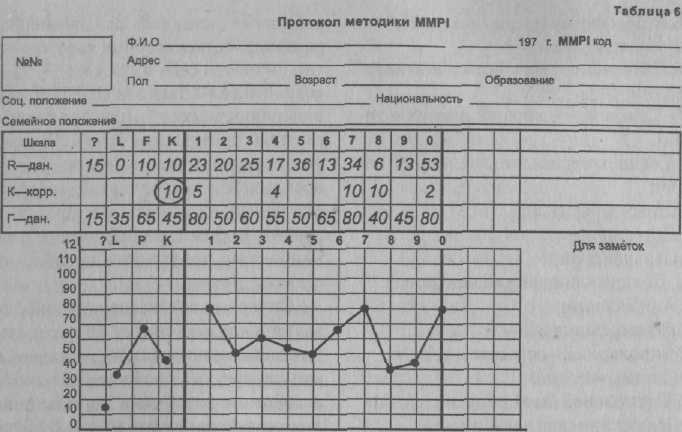 Clin Neuropsychol. 2016 May;30(4):473-96. [PubMed: 27214667]
Clin Neuropsychol. 2016 May;30(4):473-96. [PubMed: 27214667]- 8.
Tarescavage AM, Scheman J, Ben-Porath YS. Reliability and validity of the Minnesota Multiphasic Personality Inventory-2-Restructured Form (MMPI-2-RF) in evaluations of chronic low back pain patients. Psychol Assess. 2015 Jun;27(2):433-446. [PubMed: 25436662]
- 9.
Whitman MR, Tarescavage AM, Glassmire DM, Burchett D, Sellbom M. Examination of differential validity of MMPI-2-RF scores by gender and ethnicity in predicting future suicidal and violent behaviors in a forensic sample. Psychol Assess. 2019 Mar;31(3):404-409. [PubMed: 30520653]
- 10.
Marshall RE, Milligan-Saville JS, Steel Z, Bryant RA, Mitchell PB, Harvey SB. A prospective study of pre-employment psychological testing amongst police recruits. Occup Med (Lond). 2020 May 27;70(3):162-168. [PubMed: 32040153]
- 11.
Lee TTC, Taylor AM, Holbert AM, Graham JR. MMPI-2-RF predictors of interpersonal relationship characteristics in committed couples.
Psychol Assess. 2019 Sep;31(9):1118-1124. [PubMed: 31192629]
- 12.
Fariña F, Redondo L, Seijo D, Novo M, Arce R. A meta-analytic review of the MMPI validity scales and indexes to detect defensiveness in custody evaluations. Int J Clin Health Psychol. 2017 May-Aug;17(2):128-138. [PMC free article: PMC6220924] [PubMed: 30487888]
- 13.
Deskovitz MA, Weed NC, McLaughlan JK, Williams JE. Interpretive Reliability of Six Computer-Based Test Interpretation Programs for the Minnesota Multiphasic Personality Inventory-2. Assessment. 2016 Apr;23(2):250-61. [PubMed: 25944798]
- 14.
Menton WH, Crighton AH, Tarescavage AM, Marek RJ, Hicks AD, Ben-Porath YS. Equivalence of Laptop and Tablet Administrations of the Minnesota Multiphasic Personality Inventory-2 Restructured Form. Assessment. 2019 Jun;26(4):661-669. [PubMed: 28618858]
- 15.
Tarescavage AM, Ben-Porath YS. Examination of the feasibility and utility of flexible and conditional administration of the Minnesota Multiphasic Personality Inventory-2-Restructured Form.
Psychol Assess. 2017 Nov;29(11):1337-1348. [PubMed: 28165271]
- 16.
Handel RW. An Introduction to the Minnesota Multiphasic Personality Inventory-Adolescent-Restructured Form (MMPI-A-RF). J Clin Psychol Med Settings. 2016 Dec;23(4):361-373. [PubMed: 27752979]
| Psychodiagnostics of a psychologist at school - Diagnostics of the emotional and personal sphere |
| Personality typology in schools MMPI Evaluation scales are designed to identify the test subject's attitudes towards testing. The MMPI has three rating scales: the Lie Scale (L), the Confidence Scale (F), and the Correction Scale (K). 8. Schizoid Scale The eighth MMPI scale is designed to diagnose the schizoid personality type. The most common feature of persons of the schizoid (or autistic) type is the lack of unity and coherence of mental activity, bizarre and paradoxical thinking, emotions and behavior. 10. Scale of social introversion ( Si ). This MMPI scale measures the degree of closeness of the subject to the introverted personality type. [1] [2] [3] |
What you need to know about the MMPI
The Minnesota Multiphasic Personality Inventory (MMPI) is one of the most commonly used psychological tests in the world.
The test was developed by clinical psychologist Starke Hathaway and neuropsychiatrist JC McKinley, two professors at the University of Minnesota. It was created to be a tool for mental health professionals to help diagnose mental health disorders.
It was created to be a tool for mental health professionals to help diagnose mental health disorders.
Since its publication in 1943, the test has been updated several times in an attempt to eliminate racial and gender bias and make it more accurate. The updated test, known as MMPI-2, has been adapted for use in more than 40 countries.
This article takes a closer look at the MMPI-2 test, what it is used for, and how it can help diagnose.
What is MMPI-2?
MMPI-2 is a self-report questionnaire with 567 true-false questions about yourself. Your answers will help mental health professionals determine if you have symptoms of a mental illness or personality disorder.
Some questions are designed to show how you feel about taking the test. The other questions are designed to show if you are sincere or underreporting or overreporting in an attempt to influence the test results.
For most people, the MMPI-2 test takes 60 to 90 minutes.
Are there other versions?
A shorter version of the test, the restructured form MMPI-2 (RF), consists of 338 questions.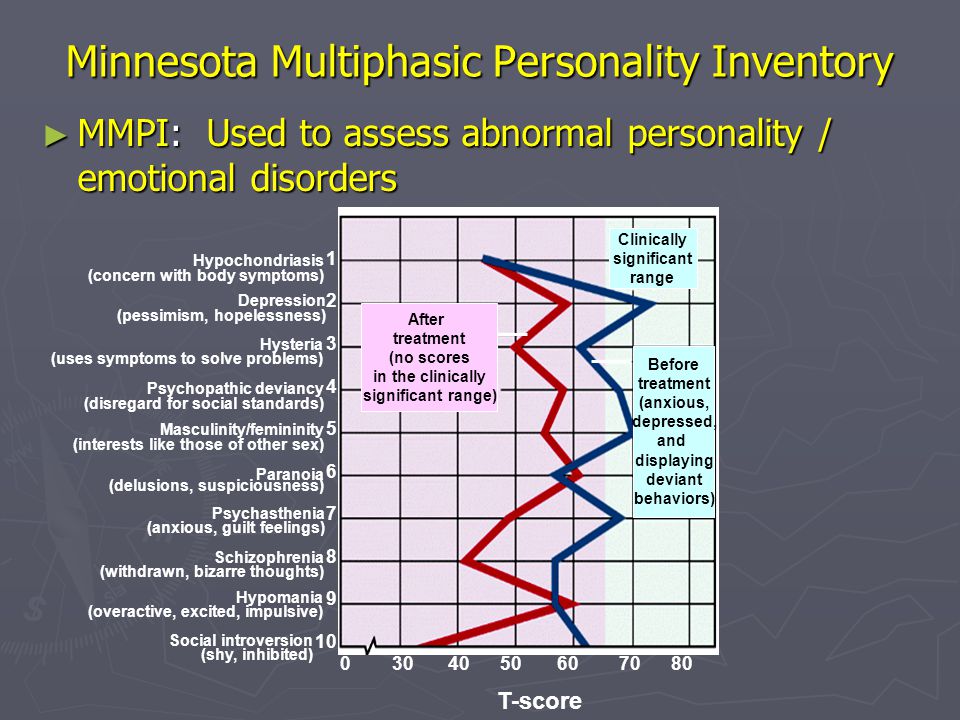 This shortened version takes less time - 35 to 50 minutes for most people.
This shortened version takes less time - 35 to 50 minutes for most people.
The researchers also developed a version of the test for teenagers aged 14 to 18. This test, known as the MMPI-A, has 478 questions and can be completed in about an hour.
There is also a shorter version of the test for teenagers called MMPI-A-RF. Released in 2016, the MMPI-A-RF contains 241 questions and takes between 25 and 45 minutes to complete.
Although shorter tests take less time, many clinicians opt for a longer evaluation because it has been studied for years.
What is it used for?
MMPI tests are used to diagnose mental disorders, but many mental health professionals do not rely on a single test to make a diagnosis. They usually prefer to collect information from many sources, including their own interactions with the person being tested.
MMPI should only be administered by a trained test administrator, but test results are sometimes used in other settings.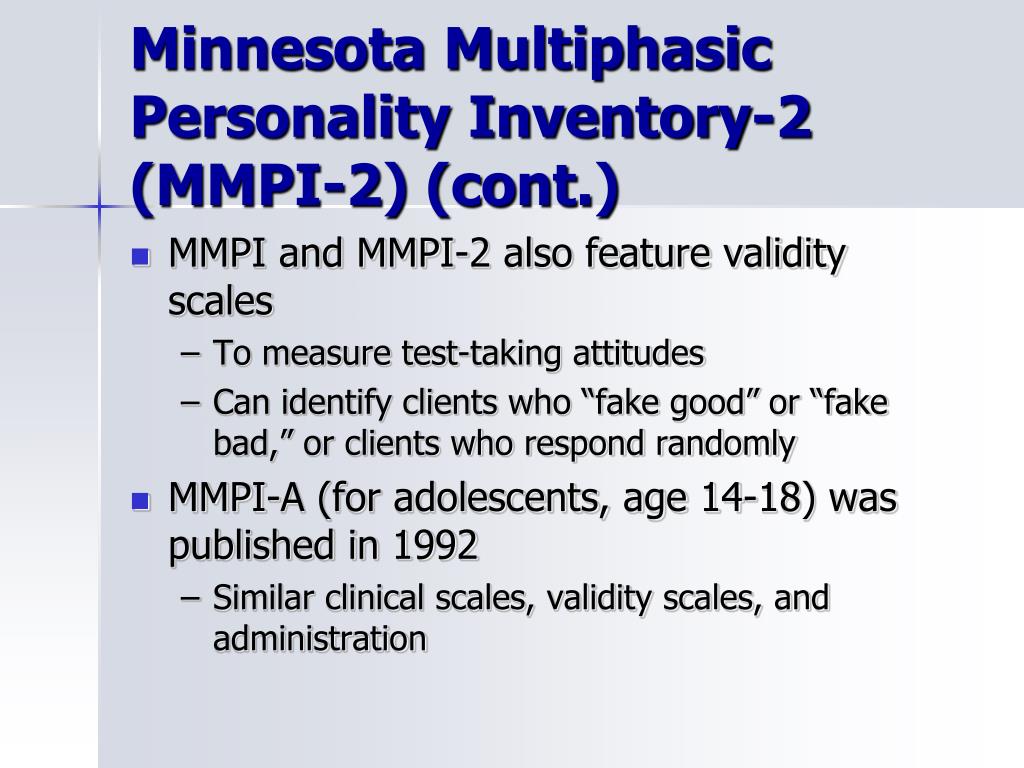
The MMPI score is sometimes used in child custody disputes, substance abuse programs, educational institutions, and even employment.
It is important to note that the use of the MMPI as part of the job qualification process has caused some controversy. Some proponents argue that this violates provisions of the Americans with Disabilities Act (ADA).
What are MMPI Clinical Scales?
The MMPI tests are designed to find out where you are on ten different mental health scales.
Each scale refers to a different psychological pattern or state, but there is much in common between the scales. Generally speaking, very high scores may indicate a mental disorder.
Here is a brief explanation of what each scale measures.
Scale 1: Hypochondria
This scale has 32 items and is designed to measure whether you have an unhealthy concern for your own health.
A high score on this scale may indicate that your health concerns are interfering with your life and causing problems in your relationships.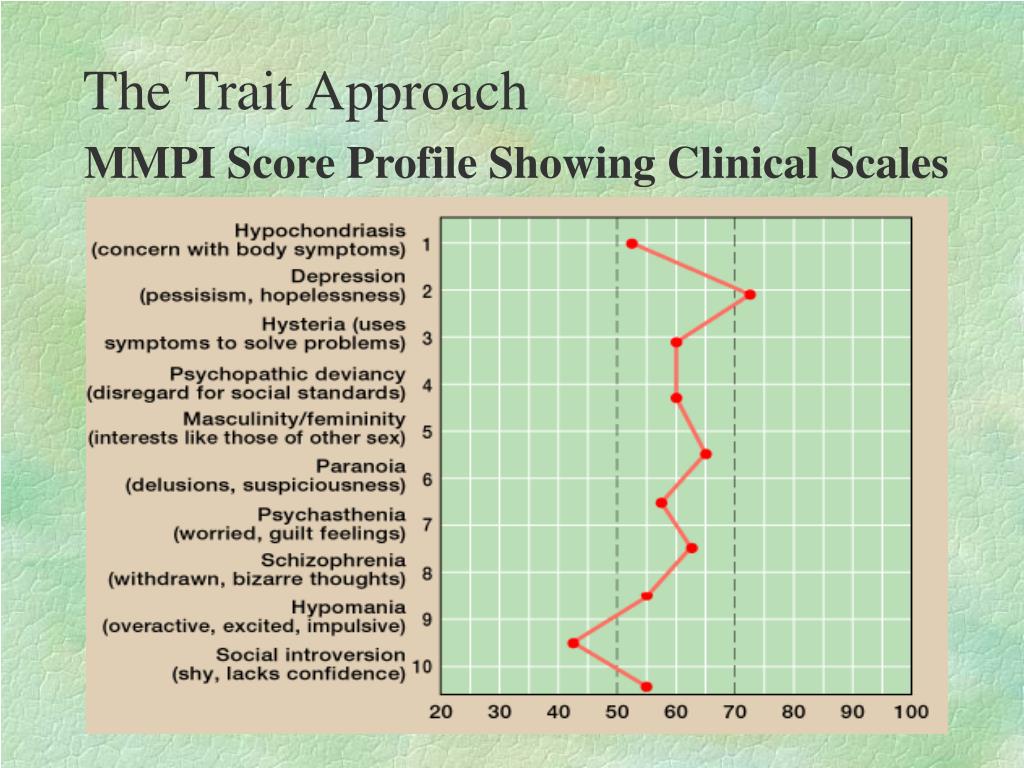
For example, a person with a high score on Scale 1 may be prone to developing physical symptoms without an underlying cause, especially during times of high stress.
Scale 2: Depression
This 57-item scale measures satisfaction with one's own life.
A person with a very high score on Scale 2 may be dealing with clinical depression or frequent suicidal thoughts.
A slightly higher score on this scale may indicate that you are withdrawn or unhappy with your circumstances.
Scale 3: Hysteria.
This 60-item scale assesses your response to stress, including your physical symptoms and your emotional response to stress.
Research has shown that people with chronic pain may score higher on the first three scales due to long-term and increased health problems.
Scale 4: Psychopathic Deviation
This scale was originally designed to measure whether you are experiencing psychopathology.
His 50 points measure antisocial behavior and attitudes, in addition to compliance or resistance to authority.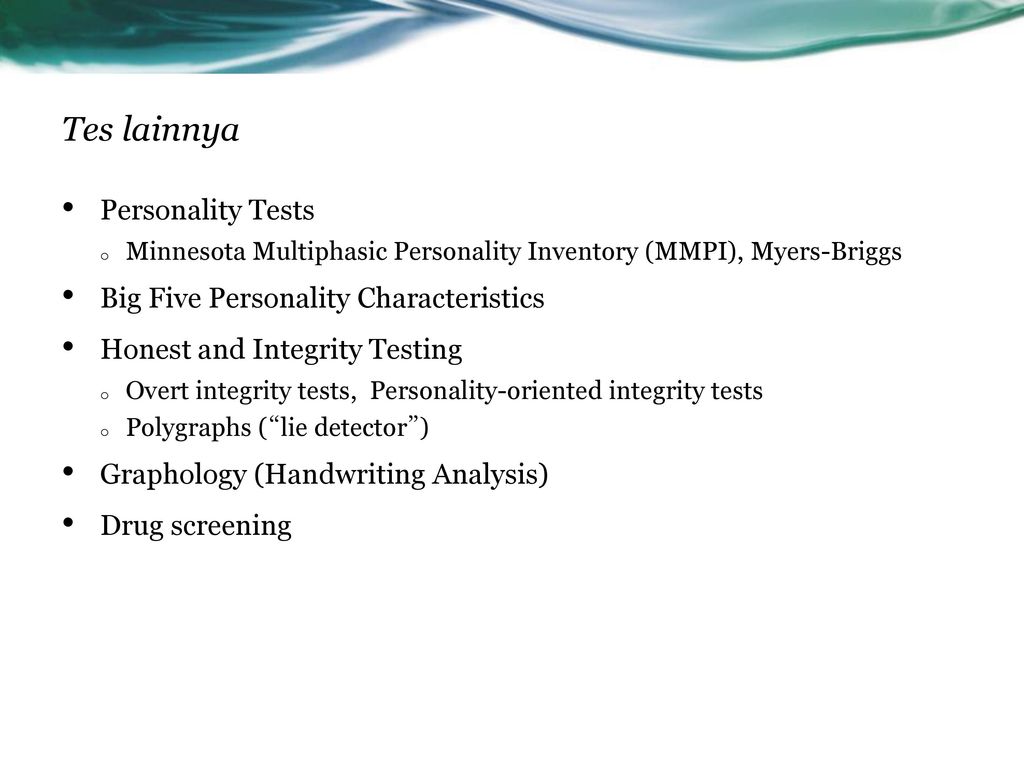
If you score very high on this scale, you may be diagnosed with a personality disorder.
Scale 5: Masculinity/Femininity
The original purpose of this 56-question section of the test was to obtain information about people's sexuality. This comes from a time when some mental health professionals viewed same-sex attraction as a disorder.
Today, this scale is used to measure how consistently you identify with gender norms.
Scale 6: paranoia
This 40-item scale assesses symptoms associated with psychosis, specifically:
High scores on this scale may indicate that you are dealing with either psychosis or paranoid personality disorder.
Scales 7: Psychasteniya
This scale of 48 points measures:
- Anxiety
- Depression
- Compulsive behavior
- Symptoms of obsessive and compulsive debris (OKR) but mental health professionals still use this scale to rate unhealthy compulsions and the destructive feelings they cause.
- excessive non-directional energy
- rapid speech
- racing thoughts
- hallucinations
- impulsiveness
- megalomania
- competitiveness
- compliance
- timidity
- reliability
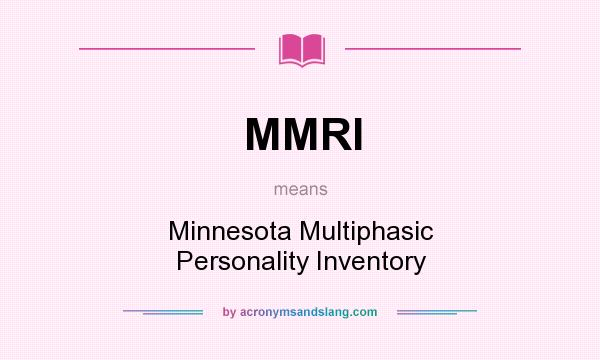
Scale 8: Schizophrenia
This 78-item scale is designed to indicate whether you have or are likely to develop a schizophrenic disorder.
It takes into account whether you experience hallucinations, delusions, or bouts of highly disorganized thinking. It also determines to what extent you may feel alienated from the rest of society.
Scale 9: Hypomania
This 46-item scale aims to assess symptoms associated with hypomania, including:
Scale 10: Social Introversion
One of the more recent additions to the MMPI, this 69-item scale measures extraversion or introversion. This is the degree to which you seek or refuse social interactions.
This scale takes into account, among other things, your:
And the scale of validity?
Confidence scales help test administrators understand how sincere test takers' answers are.
In situations where test results can affect a person's life, such as employment or child custody, people may be motivated to overreport, underreport, or be dishonest. These scales help to identify inaccurate answers.
The "L" or Lie Scale
People who score high on the "L" scale may try to present themselves in a bright positive light by refusing to acknowledge traits or reactions that they fear might cast them in a bad light.
"F" scale
Unless they choose random responses, people with high scores on this scale may try to appear worse off than they really are.
These test items are designed to identify inconsistencies in sample responses. It is important to note that a high F score can also indicate severe distress or psychopathology.
K Scale
These 30 test items focus on self-control and relationships. They are designed to identify a person's defensive reaction to certain issues and character traits.
Like the L scale, the K scale items are designed to emphasize a person's need for positive perception.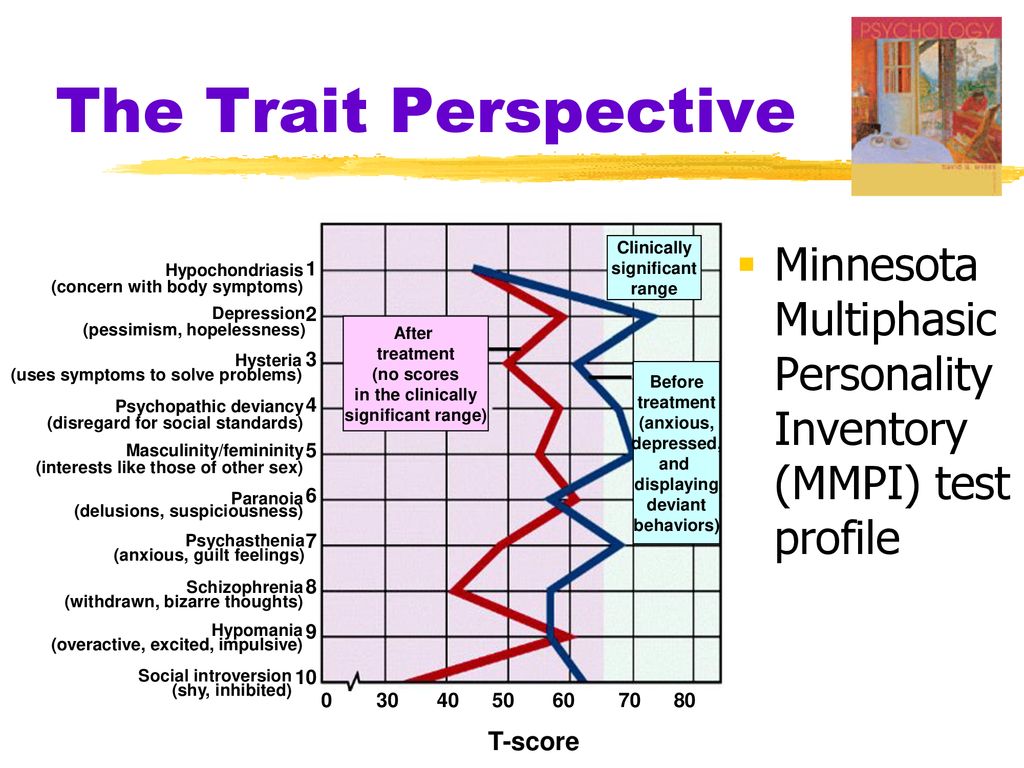
CNS Scale
This whole test score, sometimes called the Can't Tell scale, measures how often a person does not answer a test question.
Tests with more than 30 unanswered questions may be invalidated.
TRIN and VRIN scales
These two scales define response patterns that indicate that the subject has selected answers without actually considering the question.
In a TRIN (True Response Inconsistency) pattern, someone uses a fixed response pattern, such as five "correct" responses followed by five "false" responses.
In the VRIN (Variable Response Inconsistency) template, a person responds with random "true" and "false" responses.
Facebook Scale
To identify significant differences in responses between the first and second parts of the test, test administrators review 40 questions in the second half of the test, which are generally frowned upon.
If you answer 20 times more "true" than "false" to these questions, the test administrator may conclude that something is skewing your answers.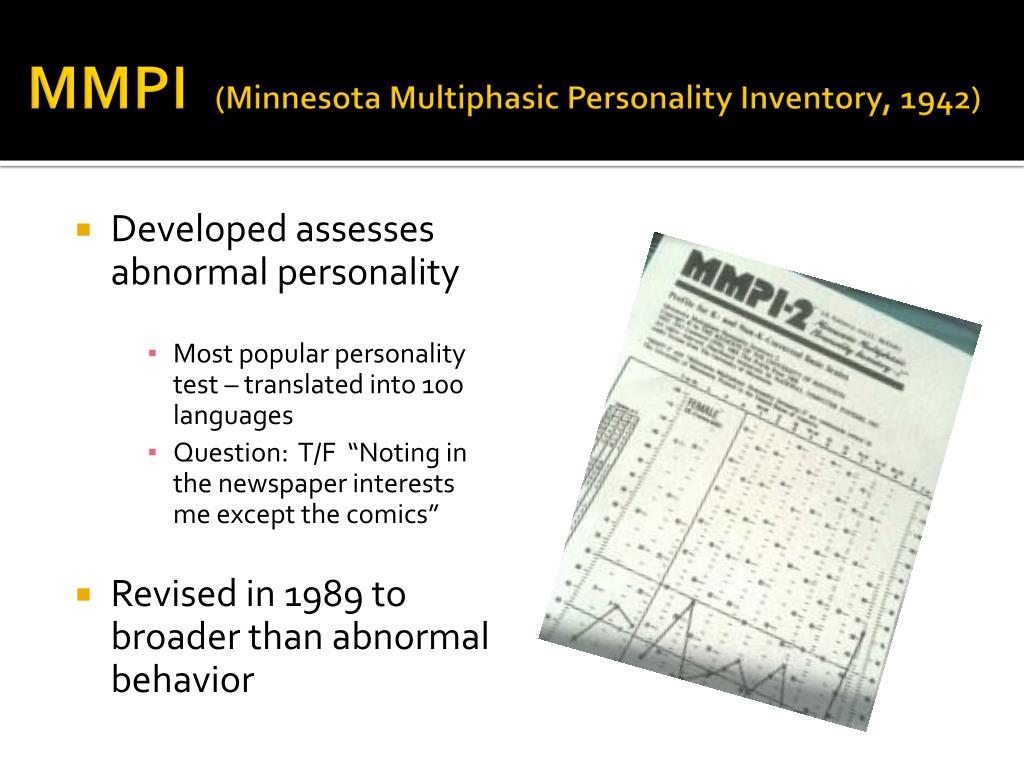
This may be because you are tired, frustrated or distracted, or you have started to over-report for another reason.
Fp Scale
These 27 test items are designed to determine whether you intentionally or unintentionally report too much, which may indicate a mental disorder or a severe disorder.
FBS Scale
This 43-item test, sometimes referred to as the "symptom fidelity" scale, is designed to detect intentional overestimation of symptoms. This can sometimes happen when people file personal injury or disability claims.
The S Scale
The Excellent Self Presentation scale shows how you answer 50 questions about calmness, contentment, morality, human kindness, and the virtues of patience. This is to see if you can deliberately skew the answers in order to look better.
If you underreport 44 out of 50 questions, the scale indicates that you may feel defensive.
What does the test include?
MMPI-2 contains a total of 567 test items and will take you 60 to 90 minutes to complete.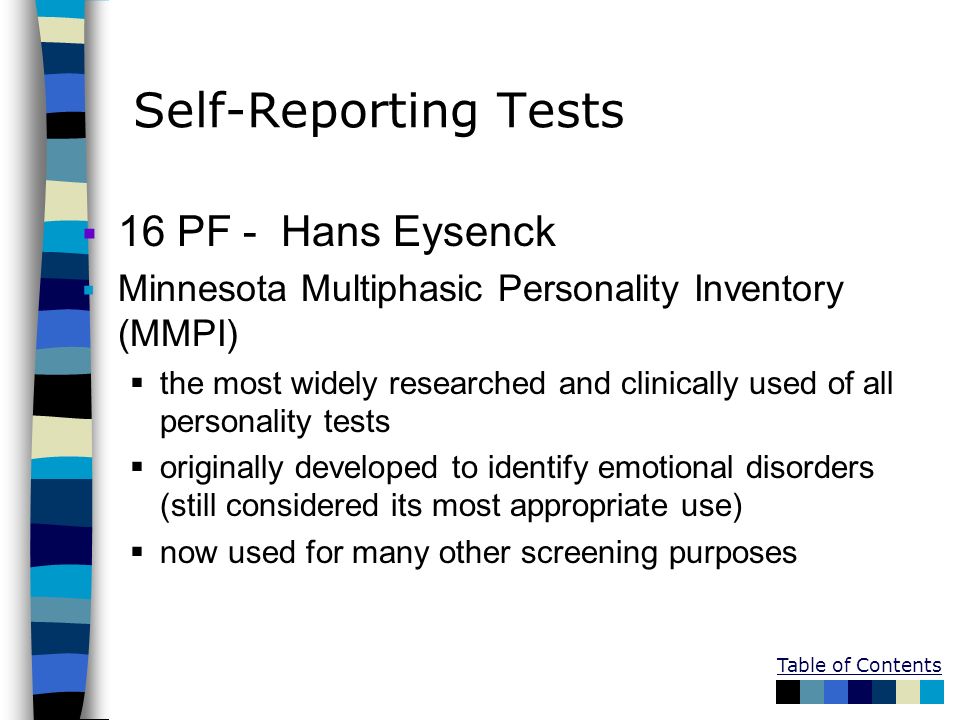 If you are taking the MMPI2-RF test, you should spend 35 to 50 minutes answering 338 questions.
If you are taking the MMPI2-RF test, you should spend 35 to 50 minutes answering 338 questions.
Booklets are available, but you can also take the test online on your own or in a group.
The test is copyrighted by the University of Minnesota. It is important that your test is administered and graded according to official guidelines.
To ensure that your test results are correctly interpreted and explained, it is recommended that you work with a clinical psychologist or psychiatrist specially trained in this type of testing.
Bottom Line
The MMPI is a well-studied and respected test designed to help mental health professionals diagnose disorders and mental health conditions.
This is a self-report questionnaire that assesses where you are on 10 scales associated with various mental disorders. The test also uses confidence scales to help test administrators understand how you feel about taking the test and whether you answered questions correctly and honestly.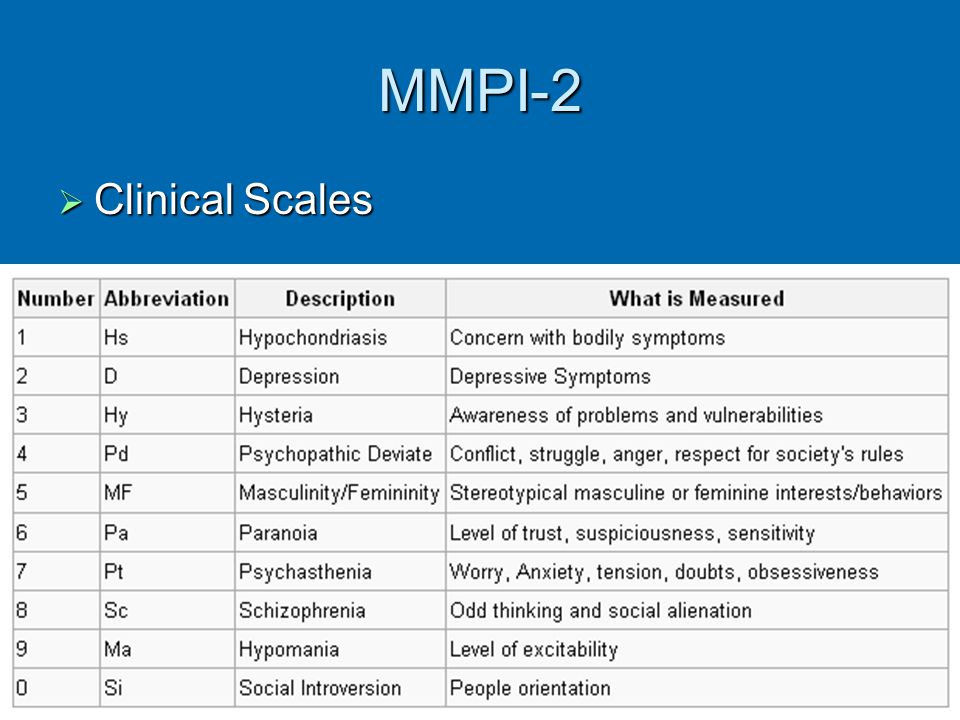
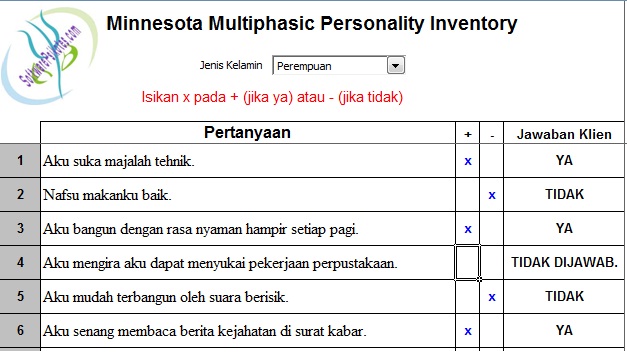 Each MMPI scale essentially represents a "separating rule" for the differential diagnosis of healthy subjects from one of ten variants of pathological personality development, and an individual score on the test scale is an indicator of the "proximity" of the subject to the corresponding variant of disharmonic personality development, i.e. rule for diagnosing personality type.
Each MMPI scale essentially represents a "separating rule" for the differential diagnosis of healthy subjects from one of ten variants of pathological personality development, and an individual score on the test scale is an indicator of the "proximity" of the subject to the corresponding variant of disharmonic personality development, i.e. rule for diagnosing personality type. 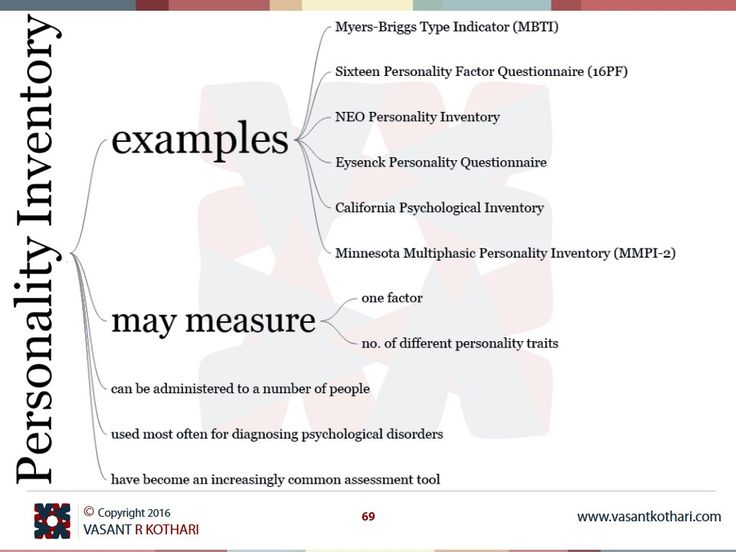 The scores on this scale are high if there is aggravation, emphasizing pathopsychological symptoms, or if the answers are random, when the subject pays little attention to the content of the statements.
The scores on this scale are high if there is aggravation, emphasizing pathopsychological symptoms, or if the answers are random, when the subject pays little attention to the content of the statements. 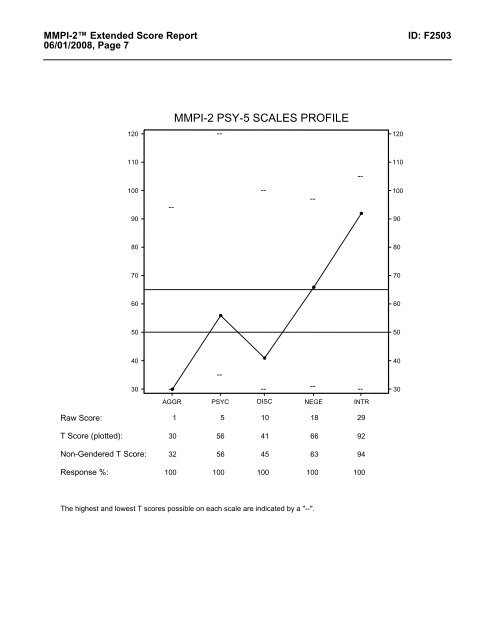
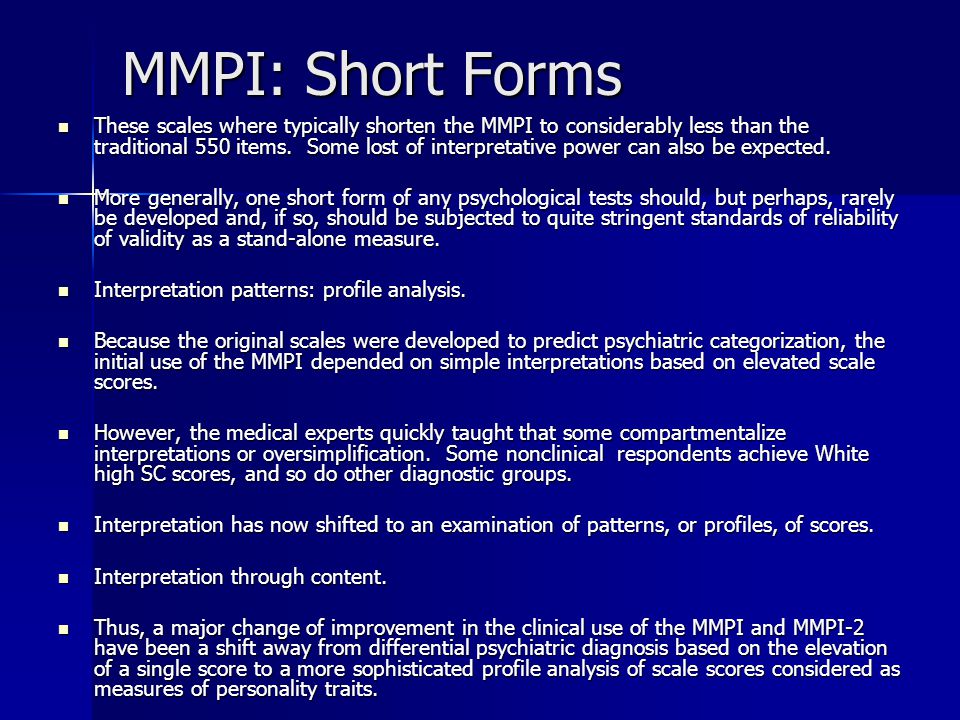 But at the same time, they are unpretentious, content with little, and endure the usual difficulties well.
But at the same time, they are unpretentious, content with little, and endure the usual difficulties well. 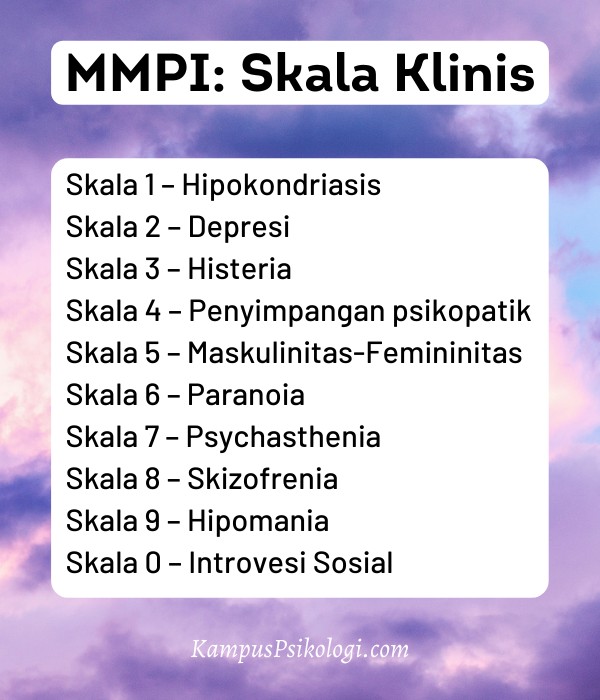 The third scale was formed to identify individuals prone to neurotic defensive reactions of the conversion type. They use the symptoms of a physical illness as a means of resolving difficult situations or as a way to avoid full responsibility. All problems are resolved by "leaving" the disease. They willingly "play" the role of the sick, and society therefore must release them from responsibility until recovery, which occurs only when the difficulties disappear. But as soon as there is a threat to return to reality, these individuals immediately become worse again. This is not a pretense, but a stable unconscious way of mental adaptation. All signs of social causes of anxiety are forced out of consciousness, and maladaptation is felt as a physical illness.
The third scale was formed to identify individuals prone to neurotic defensive reactions of the conversion type. They use the symptoms of a physical illness as a means of resolving difficult situations or as a way to avoid full responsibility. All problems are resolved by "leaving" the disease. They willingly "play" the role of the sick, and society therefore must release them from responsibility until recovery, which occurs only when the difficulties disappear. But as soon as there is a threat to return to reality, these individuals immediately become worse again. This is not a pretense, but a stable unconscious way of mental adaptation. All signs of social causes of anxiety are forced out of consciousness, and maladaptation is felt as a physical illness. 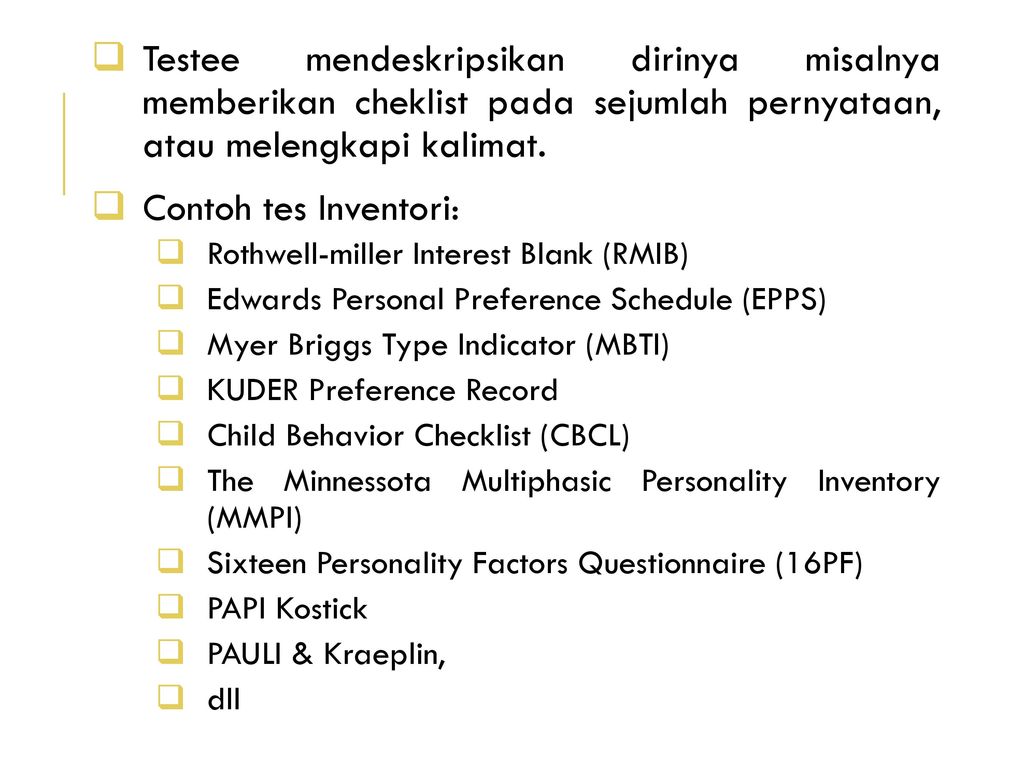 The grief of the hysterical personality is that she lacks the depth and willpower to strive for achievements for the sake of the cause, and not for the sake of attracting attention. Their every act, every gesture, every movement is designed for the viewer, for an external effect, everything in them is false and theatrical. Their emotional life is capricious, unstable, feelings are superficial, attachments are fragile and interests are shallow; their will is incapable of prolonged exertion in the name of goals that do not promise them immediate laurels and admiration from those around them.
The grief of the hysterical personality is that she lacks the depth and willpower to strive for achievements for the sake of the cause, and not for the sake of attracting attention. Their every act, every gesture, every movement is designed for the viewer, for an external effect, everything in them is false and theatrical. Their emotional life is capricious, unstable, feelings are superficial, attachments are fragile and interests are shallow; their will is incapable of prolonged exertion in the name of goals that do not promise them immediate laurels and admiration from those around them. 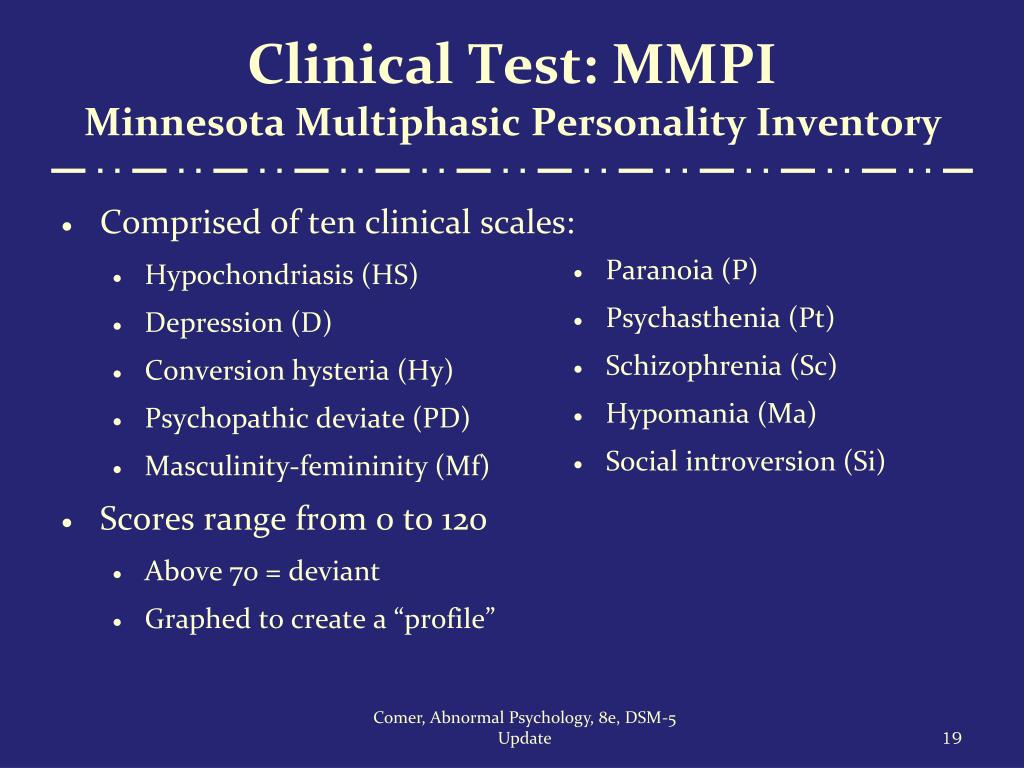 In this case, a change in circumstances will change the assessment on the psychopathy scale.
In this case, a change in circumstances will change the assessment on the psychopathy scale. 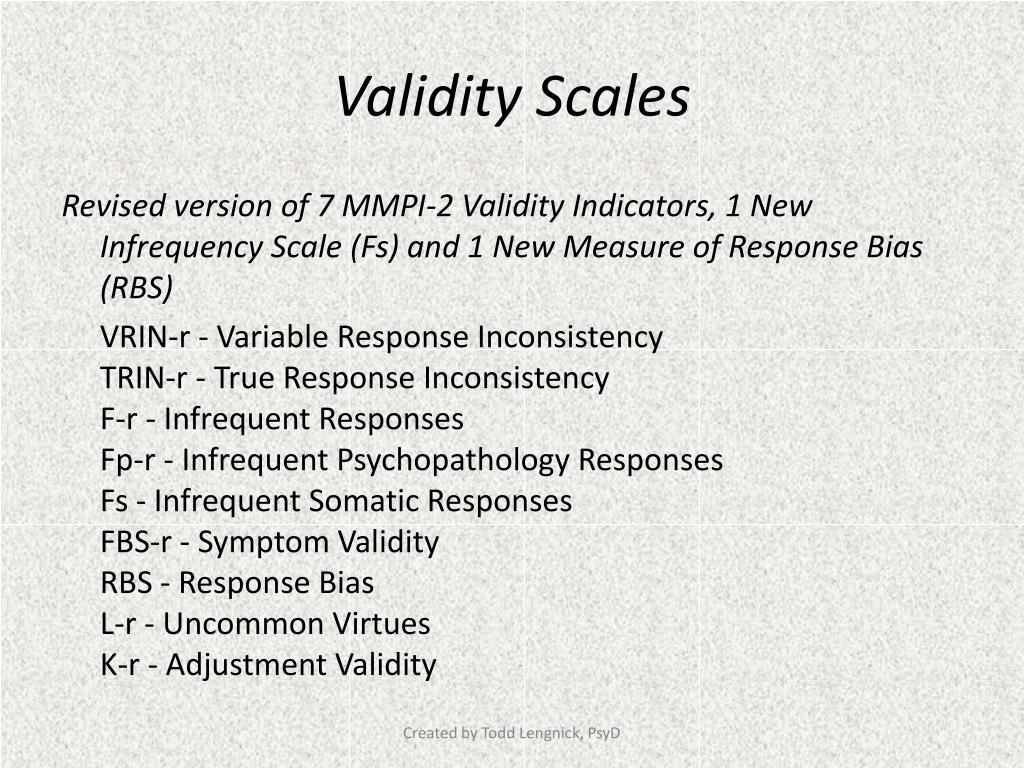 Moreover, for men, "proximity" to the female personality type is assessed, and for women - to the male.
Moreover, for men, "proximity" to the female personality type is assessed, and for women - to the male. 
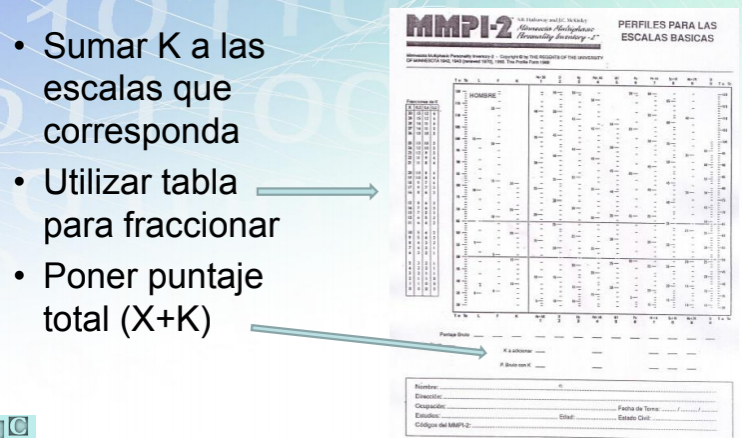 They evaluate all people only by how they relate to their activities, to their words and ideas. Whoever does not agree with them, who thinks otherwise, in his own way, is either a stupid person or an enemy. Since a person with a paranoid personality type not only has his own views, but also actively promotes them, is shy in the implementation of his plans, he often has conflicts with others. He is aggressive, vindictive, ruthless. Seeing the cause of his misfortunes in certain people, he considers it his duty to take revenge, does not forgive anyone for any trifle, any offense. He is not afraid of single combat with those who are stronger and more powerful, and when he is defeated, he does not despair and does not lose heart, but, on the contrary, draws strength from failures for a new struggle.
They evaluate all people only by how they relate to their activities, to their words and ideas. Whoever does not agree with them, who thinks otherwise, in his own way, is either a stupid person or an enemy. Since a person with a paranoid personality type not only has his own views, but also actively promotes them, is shy in the implementation of his plans, he often has conflicts with others. He is aggressive, vindictive, ruthless. Seeing the cause of his misfortunes in certain people, he considers it his duty to take revenge, does not forgive anyone for any trifle, any offense. He is not afraid of single combat with those who are stronger and more powerful, and when he is defeated, he does not despair and does not lose heart, but, on the contrary, draws strength from failures for a new struggle. 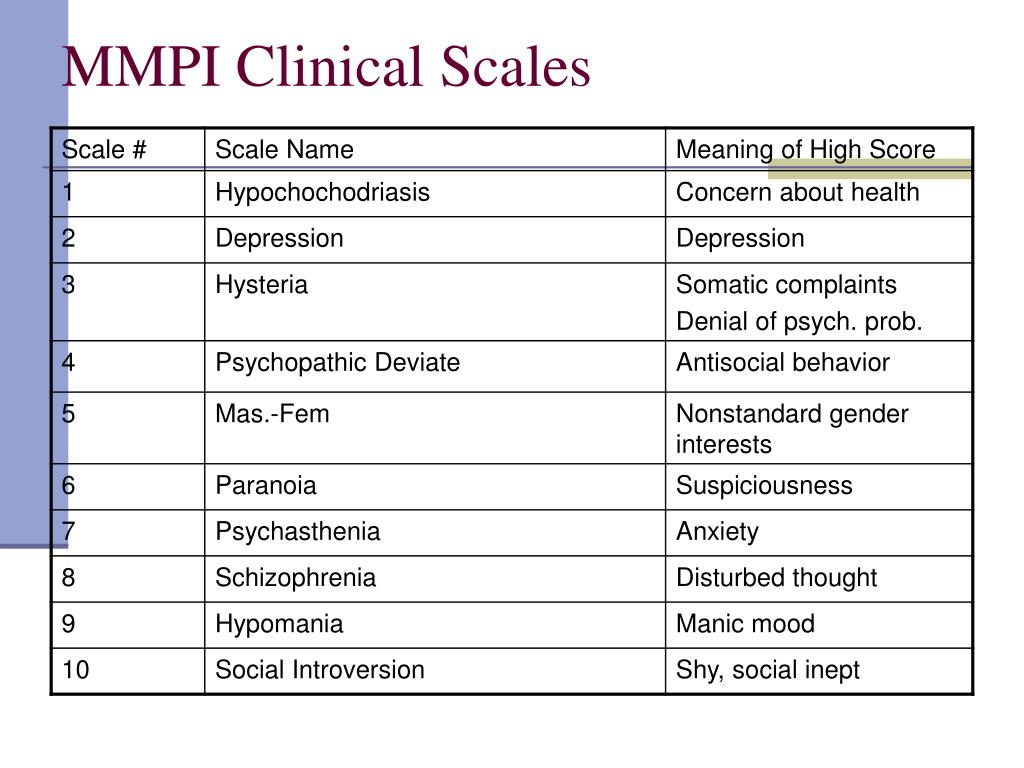
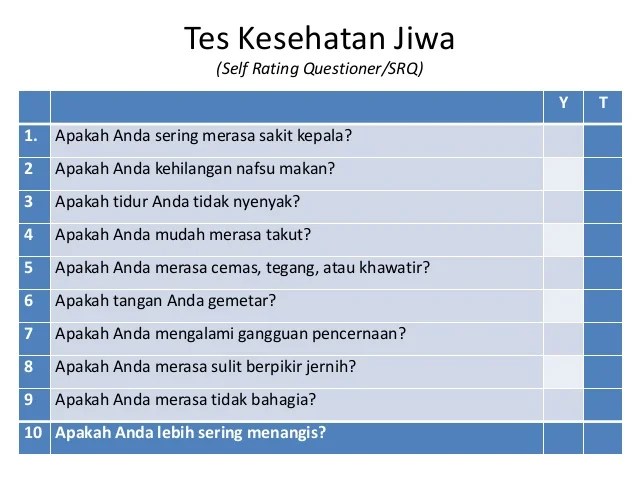 In these cases, all psychasthenic character traits become even more aggravated: anxiety, self-doubt, a tendency to doubt.
In these cases, all psychasthenic character traits become even more aggravated: anxiety, self-doubt, a tendency to doubt. 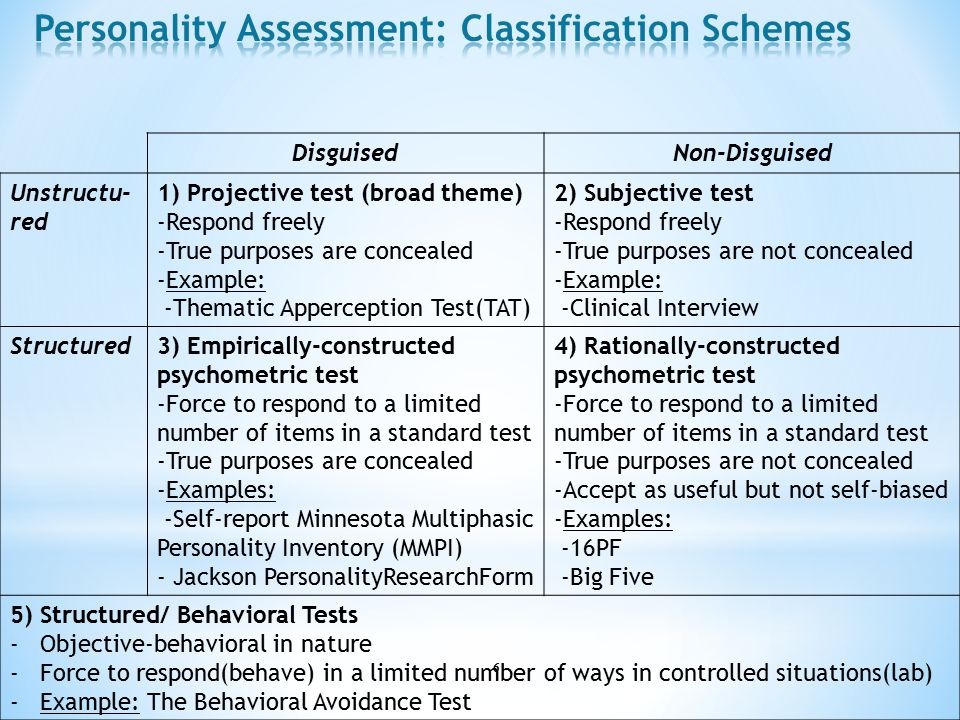 They remain indifferent and cold to the requests of their friends and relatives, they are not interested in life's problems, they are often touchy, angry, aggressive and conflicted. Few people understand their spiritual movements, but they themselves cannot and do not strive to understand anyone. Their attention is selectively directed only to the problems that interest them, outside of which they show complete indifference and ignorance.
They remain indifferent and cold to the requests of their friends and relatives, they are not interested in life's problems, they are often touchy, angry, aggressive and conflicted. Few people understand their spiritual movements, but they themselves cannot and do not strive to understand anyone. Their attention is selectively directed only to the problems that interest them, outside of which they show complete indifference and ignorance.  Timid, impressionable, closed, they avoid painfully injuring contacts, live in a world of their own fictions and fantasies.
Timid, impressionable, closed, they avoid painfully injuring contacts, live in a world of their own fictions and fantasies. 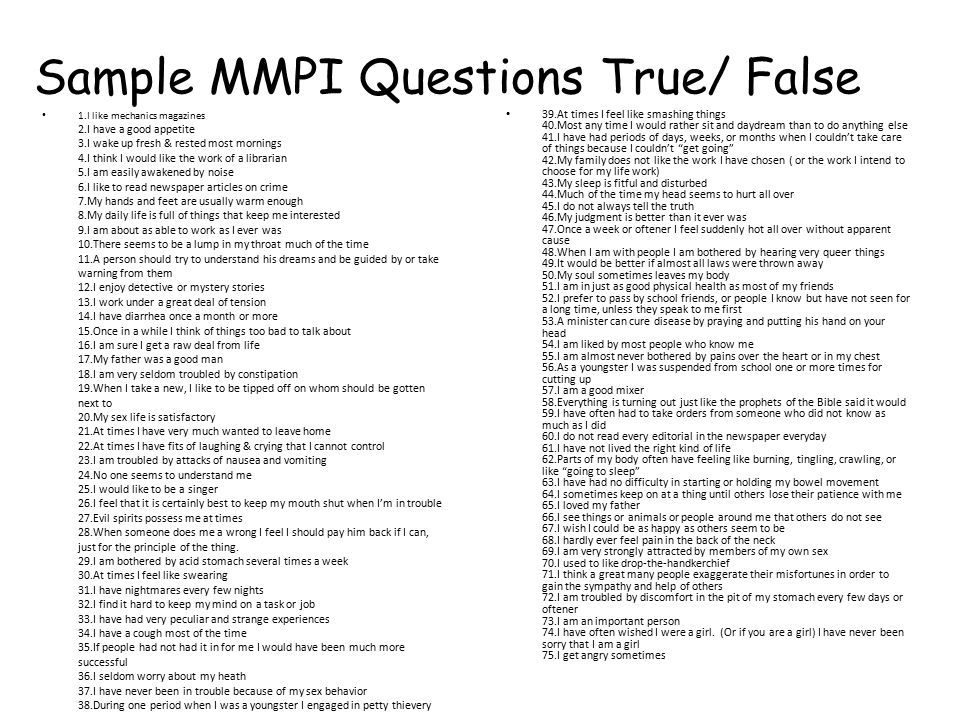 They love work with frequent changes, they are burdened by monotony and their duties, they willingly contact people. They have a high need for communication, to share their experiences with people, the need to "merge with the world." They are drawn to everything bright, catchy. They are flirtatious, love bright outfits, usually good dancers, athletes, although here they are not interested in the result, but in the process itself. They have wide variable gestures, rich facial expressions, good coordination. Often these individuals are gifted and intellectually. They have versatile abilities, are active and active, but their interests are superficial and unstable, they lack perseverance and endurance. All behavior of persons of this type is characterized by an increase in drives and a weakening of delays. Therefore, they often do not notice the boundaries between what is permitted and what is forbidden. These are people who do not tolerate the constraint of their freedom, do not take into account other people's opinions, do not tolerate criticism in their address, with high conceit, often deceitful, unnecessary and unscrupulous.
They love work with frequent changes, they are burdened by monotony and their duties, they willingly contact people. They have a high need for communication, to share their experiences with people, the need to "merge with the world." They are drawn to everything bright, catchy. They are flirtatious, love bright outfits, usually good dancers, athletes, although here they are not interested in the result, but in the process itself. They have wide variable gestures, rich facial expressions, good coordination. Often these individuals are gifted and intellectually. They have versatile abilities, are active and active, but their interests are superficial and unstable, they lack perseverance and endurance. All behavior of persons of this type is characterized by an increase in drives and a weakening of delays. Therefore, they often do not notice the boundaries between what is permitted and what is forbidden. These are people who do not tolerate the constraint of their freedom, do not take into account other people's opinions, do not tolerate criticism in their address, with high conceit, often deceitful, unnecessary and unscrupulous.